May 2, 2022 · by harveyorgan · in Uncategorized · Leave a comment·Edit
May 2, 2022 · by harveyorgan · in Uncategorized · Leave a comment·Edit
GOLD; $1864.05 DOWN $46.20
SILVER: $22.57 DOWN $0.47
ACCESS MARKET: GOLD $1863.30
SILVER: $22.64
Bitcoin morning price: $38,661 UP 227
Bitcoin: afternoon price: $38,333 DOWN 100
Platinum price: closing DOWN $11.50 to $937.95
Palladium price; closing DOWN $110.05 at $2210.70
END
DONATE
Click here if you wish to send a donation. I sincerely appreciate it as this site takes a lot of preparation
comex notices/ 20/54
EXCHANGE: COMEX
CONTRACT: MAY 2022 COMEX 100 GOLD FUTURES
SETTLEMENT: 1,909.300000000 USD
INTENT DATE: 04/29/2022 DELIVERY DATE: 05/03/2022
FIRM ORG FIRM NAME ISSUED STOPPED
657 H MORGAN STANLEY 19
661 C JP MORGAN 20
690 C ABN AMRO 20 3
709 C BARCLAYS 10
732 C RBC CAP MARKETS 1
737 C ADVANTAGE 34 1
TOTAL: 54 54
MONTH TO DATE: 1,442
:
NUMBER OF NOTICES FILED TODAY FOR MAY CONTRACT 54 NOTICE(S) FOR 5,400 OZ (0.1679 TONNES)
total notices so far: 1442 contracts for 144,200. oz (4.4852 tonnes)
SILVER NOTICES:
80 NOTICE(S) FILED 400,000 OZ/
total number of notices filed so far this month 1752 : for 8,750,000 oz
END
Russia is a major supplier of silver to London while Mexico supplies the COMEX
With the sanctions, London has no way to obtain silver other than compete with NY.
END
GLD
WITH GOLD DOWN $46.20
WITH RESPECT TO GLD WITHDRAWALS: (OVER THE PAST FEW MONTHS):
GOLD IS “RETURNED” TO THE BANK OF ENGLAND WHEN CALLING IN THEIR LEASES: THE GOLD NEVER LEAVES THE BANK OF ENGLAND IN THE FIRST PLACE. THE BANK IS PROTECTING ITSELF IN CASE OF COMMERCIAL FAILURE
ALSO INVESTORS SWITCHING TO SPROTT PHYSICAL (phys) INSTEAD OF THE FRAUDULENT GLD//
A HUGE CHANGE IN GOLD INVENTORY AT THE GLD: A WITHDRAWAL OF 1.17 TONNES FROM THE GLD.
INVENTORY RESTS AT 1094.55 TONNES
Silver//SLV
WITH NO SILVER AROUND AND SILVER DOWN 47 CENTS
AT THE SLV// A SMALL CHANGE IN SILVER INVENTORY AT THE SLV://A WITHDRAWAL OF 554,000 OZ
INVESTORS ARE SWITCHING SLV TO SPROTT’S PSLV
CLOSING INVENTORY: 575.171 MILLION OZ
Let us have a look at the data for today
SILVER//OUTLINE
SILVER COMEX OI FELL BY A STRONG SIZED 949 CONTRACTS TO 135,949 AND FURTHER FROM THE NEW RECORD OF 244,710, SET FEB 25/2020 AND THE STRONG LOSS IN OI WAS ACCOMPLISHED DESPITE OUR $0.12 LOSS IN SILVER PRICING AT THE COMEX ON FRIDAY. OUR BANKERS WERE SUCCESSFUL IN KNOCKING THE PRICE OF SILVER DOWN (IT FELL BY $0.12) AND WERE UNSUCCESSFUL IN KNOCKING OUT SOME SILVER LONGS AS WE HAD A STRONG GAIN OF 1031 CONTRACTS ON OUR TWO EXCHANGES.
WE MUST HAVE HAD:
I) HUGE BANKER SHORT COVERING AS THEY ARE VERY ANXIOUS TO GET OUT OF DODGE!!/. II)WE ALSO HAD SOME REDDIT RAPTOR BUYING//. iii) A STRONG ISSUANCE OF EXCHANGE FOR PHYSICALS iiii) A STRONG INITIAL SILVER STANDING FOR COMEX SILVER MEASURING AT 30.170 MILLION OZ FOLLOWED BY TODAY’S 1.295 EFP JUMP TO LONDON//NEW STANDING 28.875 MILLION OZ/ // V) STRONG SIZED COMEX OI LOSS/
I AM NOW RECORDING THE DIFFERENTIAL IN OI FROM PRELIMINARY TO FINAL:
THE DIFFERENTIAL FROM PRELIMINARY OI TO FINAL OI SILVER TODAY: CONTRACTS : —-222
HISTORICAL ACCUMULATION OF EXCHANGE FOR PHYSICALS MAY. ACCUMULATION FOR EFP’S SILVER/JPMORGAN’S HOUSE OF BRIBES/STARTING FROM FIRST DAY/MONTH OF APRIL:
TOTAL CONTACTS for 1 days, total 1736, contracts: 5.1556 million oz OR 5.1556 MILLION OZ PER DAY. (1736CONTRACTS PER DAY)
TOTAL EFP’S FOR THE MONTH SO FAR: 5.1556 MILLION OZ
.
LAST 11 MONTHS TOTAL EFP CONTRACTS ISSUED IN MILLIONS OF OZ:
MAY 137.83 MILLION
JUNE 149.91 MILLION OZ
JULY 129.445 MILLION OZ
AUGUST: MILLION OZ 140.120
SEPT. 28.230 MILLION OZ//
OCT: 94.595 MILLION OZ
NOV: 131.925 MILLION OZ
DEC: 100.615 MILLION OZ
JAN 2022// 90.460 MILLION OZ
FEB 2022: 72.39 MILLION OZ//
MARCH: 207.430 MILLION OZ//A NEW RECORD FOR EFP ISSUANCE AND WE ARE STILL GOING STRONG THIS MONTH.
APRIL: 114.52 MILLION OZ FINAL//LOW ISSUANCE
MAY: 5.1556 MILLION OZ//
RESULT: WE HAD A STRONG SIZED DECREASE IN COMEX OI SILVER COMEX CONTRACTS OF 949 WITH OUR $0.12 LOSS IN SILVER PRICING AT THE COMEX// FRIDAY., TODAY. THE CME NOTIFIED US THAT WE HAD A STRONG SIZED EFP ISSUANCE CONTRACTS: 705 CONTRACTS ISSUED FOR MAY AND 0 CONTRACTS ISSUED FOR ALL OTHER MONTHS) WHICH EXITED OUT OF THE SILVER COMEX TO LONDON AS FORWARDS THE DOMINANT FEATURE TODAY: /HUGE BANKER SHORT COVERING AS THEY GET OUT OF DODGE//// WE HAVE A HUGE INITIAL SILVER OZ STANDING FOR MAY. OF 30.170 MILLION OZ FOLLOWED BY TODAY;S 1.295 MILLION OZ EFP TO LONDON//NEW STANDING 28.875 MILLION OZ// .. WE HAD A STRONG SIZED GAIN OF 787 OI CONTRACTS ON THE TWO EXCHANGES FOR 3.935 MILLION OZ ACCOMPANYING THE LOSS IN PRICE.
WE HAD 80 NOTICES FILED TODAY FOR 400,000 OZ
THE SILVER COMEX IS NOW BEING ATTACKED FOR METAL BY LONDONERS ET AL.
GOLD//OUTLINE
IN GOLD, THE COMEX OPEN INTEREST ROSE BY A FAIR SIZED 2600 CONTRACTS TO 561,272 AND CLOSER TO NEW RECORD (SET JAN 24/2020) AT 799,541 AND PREVIOUS TO THAT: (SET JAN 6/2020) AT 797,110.
THE DIFFERENTIAL FROM PRELIMINARY OI TO FINAL OI IN GOLD TODAY: –103 CONTRACTS.
THE BIS HAS ABANDONED THE GOLD COMEX TRADING!!!
.
THE FAIR SIZED INCREASE IN COMEX OI CAME WITH OUR STRONG GAIN IN PRICE OF $20.05//COMEX GOLD TRADING/FRIDAY /.AS IN SILVER WE MUST HAD HUGE BANKER/ALGO SHORT COVERING ACCOMPANYING OUR FAIR SIZED EXCHANGE FOR PHYSICAL ISSUANCE. WE HAD ZERO LONG LIQUIDATION
WE ALSO HAD A HUGE INITIAL STANDING IN GOLD TONNAGE FOR MAY AT 5.353 TONNES ON FIRST DAY NOTICE /FOLLOWED BY TODAY”S QUEUE JUMP OF 6500 OZ//NEW STANDING 5.555 TONNES
YET ALL OF..THIS HAPPENED WITH OUR GAIN IN PRICE OF $20.05 WITH RESPECT TO FRIDAY’S TRADING
WE HAD A GOOD SIZED GAIN OF 6463 OI CONTRACTS (20.102 PAPER TONNES) ON OUR TWO EXCHANGES..
E.F.P. ISSUANCE
THE CME RELEASED THE DATA FOR EFP ISSUANCE AND IT TOTALED A FAIR SIZED 3968 CONTRACTS:
The NEW COMEX OI FOR THE GOLD COMPLEX RESTS AT 561,272.
IN ESSENCE WE HAVE A VERY GOOD SIZED INCREASE IN TOTAL CONTRACTS ON THE TWO EXCHANGES OF 6568, WITH 2600 CONTRACTS INCREASED AT THE COMEX AND 3968 EFP OI CONTRACTS WHICH NAVIGATED OVER TO LONDON. THUS TOTAL OI GAIN ON THE TWO EXCHANGES OF 6568 CONTRACTS OR 20.102 TONNES.
CALCULATIONS ON GAIN/LOSS ON OUR TWO EXCHANGES
WE HAD A FAIR SIZED ISSUANCE IN EXCHANGE FOR PHYSICALS (3968) ACCOMPANYING THE FAIR SIZED GAIN IN COMEX OI (2495,): TOTAL GAIN IN THE TWO EXCHANGES 6463CONTRACTS. WE NO DOUBT HAD 1) HUGE BANKER SHORT COVERING ,2.) STRONG INITIAL STANDING AT THE GOLD COMEX FOR MAY. AT 5.353 TONNES FOLLOWED BY TODAY’S QUEUE JUMP OF 6500 OZ//NEW STANDING 5.555 /// 3) ZERO LONG LIQUIDATION //.,4) FAIR SIZED COMEX OI. GAIN 5) FAIR ISSUANCE OF EXCHANGE FOR PHYSICAL/
HISTORICAL ACCUMULATION OF EXCHANGE FOR PHYSICALS IN 2022 INCLUDING TODAY
MAY
ACCUMULATION OF EFP’S GOLD AT J.P. MORGAN’S HOUSE OF BRIBES: (EXCHANGE FOR PHYSICAL) FOR THE MONTH OF APRIL :
1736 CONTRACTS OR 173,600 OR 8.680 TONNES 1 TRADING DAY(S) AND THUS AVERAGING: 1736 EFP CONTRACTS PER TRADING DAY
TO GIVE YOU AN IDEA AS TO THE SIZE OF THESE EFP TRANSFERS : THIS MONTH IN 1 TRADING DAY(S) IN TONNES: 8.660 TONNES
TOTAL ANNUAL GOLD PRODUCTION, 2021, THROUGHOUT THE WORLD EX CHINA EX RUSSIA: 3555 TONNES
THUS EFP TRANSFERS REPRESENTS 8.66/3550 x 100% TONNES 0.243% OF GLOBAL ANNUAL PRODUCTION
ACCUMULATION OF GOLD EFP’S YEAR 2021 TO 2022
JANUARY/2021: 265.26 TONNES (RAPIDLY INCREASING AGAIN)
FEB : 171.24 TONNES ( DEFINITELY SLOWING DOWN AGAIN)..
MARCH:. 276.50 TONNES (STRONG AGAIN/
APRIL: 189..44 TONNES ( DRAMATICALLY SLOWING DOWN AGAIN//GOLD IN BACKWARDATION)
MAY: 250.15 TONNES (NOW DRAMATICALLY INCREASING AGAIN)
JUNE: 247.54 TONNES (FINAL)
JULY: 188.73 TONNES FINAL
AUGUST: 217.89 TONNES FINAL ISSUANCE.
SEPT 142.12 TONNES FINAL ISSUANCE ( LOW ISSUANCE)_
OCT: 141.13 TONNES FINAL ISSUANCE (LOW ISSUANCE)
NOV: 312.46 TONNES FINAL ISSUANCE//NEW RECORD!! (INCREASING DRAMATICALLY)//SIGN OF REAL STRESS//SURPASSING THE MARCH 2021 RECORD OF 276.50 TONNES OF EFP
DEC. 175.62 TONNES//FINAL ISSUANCE//
JAN:2022 247.25 TONNES //FINAL
FEB: 196.04 TONNES//FINAL
MARCH: 409.30 TONNES INITIAL( THIS IS NOW A RECORD EFP ISSUANCE FOR MARCH AND FOR ANY MONTH.
APRIL: 169.55 TONNES (FINAL VERY LOW ISSUANCE MONTH)
MAY: 8.66 TONNES INITIAL
SPREADING OPERATIONS
(/NOW SWITCHING TO GOLD) FOR NEWCOMERS, HERE ARE THE DETAILS
SPREADING LIQUIDATION HAS NOW COMMENCED AS WE HEAD TOWARDS THE NEW ACTIVE FRONT MONTH OF MAY.WE ARE NOW INTO THE SPREADING OPERATION OF SILVER
HERE IS A BRIEF SYNOPSIS OF HOW THE CROOKS FLEECE UNSUSPECTING LONGS IN THE SPREADING ENDEAVOUR ;MODUS OPERANDI OF THE CORRUPT BANKERS AS TO HOW THEY HANDLE THEIR SPREAD OPEN INTERESTS:HERE IS HOW THE CROOKS USED SPREADING AS WE ARE NOW INTO THE NON ACTIVE DELIVERY MONTH OF APRIL HEADING TOWARDS THE ACTIVE DELIVERY MONTH OF MAY, FOR SILVER:
YOU WILL ALSO NOTICE THAT THE COMEX OPEN INTEREST STARTS TO RISE BUT SO IS THE OPEN INTEREST OF SPREADERS. THE OPEN INTEREST IN WILL CONTINUE TO RISE UNTIL ONE WEEK BEFORE FIRST DAY NOTICE OF AN UPCOMING ACTIVE DELIVERY MONTH (MAR), AND THAT IS WHEN THE CROOKS SELL THEIR SPREAD POSITIONS BUT NOT AT THE SAME TIME OF THE DAY. THEY WILL USE THE SELL SIDE OF THE EQUATION TO CREATE THE CASCADE (ALONG WITH THEIR COLLUSIVE FRIENDS) AND THEN COVER ON THE BUY SIDE OF THE SPREAD SITUATION AT THE END OF THE DAY. THEY DO THIS TO AVOID POSITION LIMIT DETECTION. THE LIQUIDATION OF THE SPREADING FORMATION CONTINUES FOR EXACTLY ONE WEEK AND ENDS ON FIRST DAY NOTICE.”
WHAT IS ALARMING TO ME, ACCORDING TO OUR LONDON EXPERT ANDREW MAGUIRE IS THAT THESE EFP’S ARE BEING TRANSFERRED TO WHAT ARE CALLED SERIAL FORWARD CONTRACT OBLIGATIONS AND THESE CONTRACTS ARE LESS THAN 14 DAYS. ANYTHING GREATER THAN 14 DAYS, THESE MUST BE RECORDED AND SENT TO THE COMPTROLLER, GREAT BRITAIN TO MONITOR RISK TO THE BANKING SYSTEM. IF THIS IS INDEED TRUE, THEN THIS IS A MASSIVE CONSPIRACY TO DEFRAUD AS WE NOW WITNESS A MONSTROUS TOTAL EFP’S ISSUANCE AS IT HEADS INTO THE STRATOSPHERE.
First, here is an outline of what will be discussed tonight:
1.Today, we had the open interest at the comex, in SILVER, FELL BY A STRONG SIZED 949 CONTRACT OI TO 135,949 AND FURTHER FROM OUR COMEX RECORD //244,710(SET FEB 25/2020). THE LAST RECORDS WERE SET IN AUG.2018 AT 244,196 WITH A SILVER PRICE OF $14.78/(AUGUST 22/2018)..THE PREVIOUS RECORD TO THAT WAS SET ON APRIL 9/2018 AT 243,411 OPEN INTEREST CONTRACTS WITH THE SILVER PRICE AT THAT DAY: $16.53). AND PREVIOUS TO THAT, THE RECORD WAS ESTABLISHED AT: 234,787 CONTRACTS, SET ON APRIL 21.2017 OVER 5 YEARS AGO.
EFP ISSUANCE 1736 CONTRACTS
OUR CUSTOMARY MIGRATION OF COMEX LONGS CONTINUE TO MORPH INTO LONDON FORWARDS AS OUR BANKERS USED THEIR EMERGENCY PROCEDURE TO ISSUE:
MAY 1736 ALL OTHER MONTHS: ZERO. TOTAL EFP ISSUANCE: 0 CONTRACTS. EFP’S GIVE OUR COMEX LONGS A FIAT BONUS PLUS A DELIVERABLE PRODUCT OVER IN LONDON. IF WE TAKE THE COMEX OI LOSS OF 705 CONTRACTS AND ADD TO THE 1736 OI TRANSFERRED TO LONDON THROUGH EFP’S,
WE OBTAIN A STRONG SIZED GAIN OF 787 OPEN INTEREST CONTRACTS FROM OUR TWO EXCHANGES.
THUS IN OUNCES, THE GAIN ON THE TWO EXCHANGES 3.935 MILLION OZ
OCCURRED DESPITE OUR LOSS IN PRICE OF $0.12 IN PRICE.
OUTLINE FOR TODAY’S COMMENTARY
1/COMEX GOLD AND SILVER REPORT
(report Harvey)
2 ) Gold/silver trading overnight Europe,
(Peter Schiff,
3. Egon von Greyerz///Matthew Piepenburg via GoldSwitzerland.com,
4. Chris Powell of GATA provides to us very important physical commentaries
end
5. Other gold commentaries
.
end
6. Commodity commentaries/cryptocurrencies
3. ASIAN AFFAIRS
i)MONDAY MORNING// SUNDAY NIGHT
SHANGHAI CLOSED XX PTS OR XX% //Hang Sang CLOSED XX OR XX% /The Nikkei closed DOWN 29.37 PTS OR 0.11% //Australia’s all ordinaires CLOSED DOWN 1.31% /Chinese yuan (ONSHORE) closed DOWN 6.6084 /Oil DOWN TO 101.69 dollars per barrel for WTI and UP TO 104.10 for Brent. Stocks in Europe OPENED MOSTLY CLOSED // ONSHORE YUAN CLOSED DOWN AGAINST THE DOLLAR AT 6.6064 OFFSHORE YUAN CLOSED DOWN ON THE DOLLAR AT 6.6747: /ONSHORE YUAN TRADING ABOVE LEVEL OF OFFSHORE YUAN/ONSHORE YUAN TRADING WEAKER AGAINST US DOLLAR/OFFSHORE WEAKER//
a)NORTH KOREA
outline
b) REPORT ON JAPAN/
OUTLINE
3 C CHINA
OUTLINE
4/EUROPEAN AFFAIRS
OUTLINE
5. RUSSIAN AND MIDDLE EASTERN AFFAIRS
OUTLINE
6.Global Issues
OUTLINE
7. OIL ISSUES
OUTLINE
8 EMERGING MARKET ISSUES
COMEX DATA//AMOUNTS STANDING//VOLUME OF TRADING/INVENTORY MOVEMENTS
GOLD
LET US BEGIN:
THE TOTAL COMEX GOLD OPEN INTEREST ROSE BY A FAIR SIZED 2495 CONTRACTS TO 561,272 AND CLOSER TO THE RECORD THAT WAS SET IN JANUARY/2020: {799,541 OI(SET JAN 16/2020)} AND PREVIOUS TO THAT: 797,110 (SET JAN 7/2020). AND THIS COMEX DECREASE OCCURRED WITH OUR GAIN OF $20.05 IN GOLD PRICING FRIDAY’S COMEX TRADING. WE ALSO HAD A FAIR SIZED EFP (2844 CONTRACTS). . THEY WERE PAID HANDSOMELY NOT TO TAKE DELIVERY AT THE COMEX AND SETTLE FOR CASH.
WE NORMALLY HAVE WITNESSED EXCHANGE FOR PHYSICALS ISSUED BEING SMALL AS IT JUST TOO COSTLY FOR THEM TO CONTINUE SERVICING THE COSTS OF SERIAL FORWARDS CIRCULATING IN LONDON. HOWEVER, MUCH TO THE ANNOYANCE OF OUR BANKERS, THE COMEX IS THE SCENE OF AN ASSAULT ON GOLD AS LONDONERS, NOT BEING ABLE TO FIND ANY PHYSICAL ON THAT SIDE OF THE POND, EXERCISE THESE CIRCULATING EXCHANGE FOR PHYSICALS IN LONDON AND FORCING DELIVERY OF REAL METAL OVER HERE AS THE OBLIGATION STILL RESTS WITH NEW YORK BANKERS. IT SEEMS THAT ARE BANKERS FRIENDS ARE EXERCISING EFP’S FROM LONDON AND NOW THEY ARE LOATHE TO ISSUE NEW ONES.
EXCHANGE FOR PHYSICAL ISSUANCE
WE ARE NOW MOVING TO THE ACTIVE DELIVERY MONTH OF MAY.. THE CME REPORTS THAT THE BANKERS ISSUED A FAIR SIZED TRANSFER THROUGH THE EFP ROUTE AS THESE LONGS RECEIVED A DELIVERABLE LONDON FORWARD TOGETHER WITH A FIAT BONUS.,
THAT IS 3968 EFP CONTRACTS WERE ISSUED: ;: , . 0 JUNE :3968 & ZERO FOR ALL OTHER MONTHS:
TOTAL EFP ISSUANCE: 3968 CONTRACTS
WHEN WE HAVE BACKWARDATION, EFP ISSUANCE IS VERY COSTLY BUT THE REAL PROBLEM IS THE SCARCITY OF METAL AND IT IS FAR BETTER FOR OUR BANKERS TO PAY OFF INDIVIDUALS THAN RISK INVESTORS ESPECIALLY FROM LONDON STANDING FOR DELIVERY. THE LOWER PRICES IN THE FUTURES MARKET IS A MAGNET FOR OUR LONDONERS SEEKING PHYSICAL METAL. BACKWARDATION ALWAYS EQUAL SCARCITY OF METAL!
ON A NET BASIS IN OPEN INTEREST WE GAINED THE FOLLOWING TODAY ON OUR TWO EXCHANGES: A STRONG SIZED TOTAL OF 6463 CONTRACTS IN THAT 3968 LONGS WERE TRANSFERRED AS FORWARDS TO LONDON AND WE HAD A FAIR SIZED COMEX OI GAIN OF 2495 CONTRACTS..AND THIS GAIN OCCURRED DESPITE OUR STRONG GAIN IN PRICE OF GOLD $20.05.
// WE HAVE A STRONG AMOUNT OF GOLD TONNAGE STANDING FOR MAY (5.353),
HERE ARE THE AMOUNTS THAT STOOD FOR DELIVERY IN THE PRECEDING 12 MONTHS OF 2021:
DEC 2021: 112.217 TONNES
NOV. 8.074 TONNES
OCT. 57.707 TONNES
SEPT: 11.9160 TONNES
AUGUST: 80.489 TONNES
JULY: 7.2814 TONNES
JUNE: 72.289 TONNES
MAY 5.77 TONNES
APRIL 95.331 TONNES
MARCH 30.205 TONNES
FEB ’21. 113.424 TONNES
JAN ’21: 6.500 TONNES.
TOTAL SO FAR THIS YEAR (JAN- DEC): 601.213 TONNES
YEAR 2022:
JANUARY 2022 17.79 TONNES
FEB 2022: 59.023 TONNES
MARCH: 36.678 TONNES
APRIL: 85.340 TONNES FINAL.
MAY: 5.353 TONNES
THE BANKERS WERE UNSUCCESSFUL IN LOWERING GOLD’S PRICE //// (IT ROSE $2.35) AND WERE UNSUCCESSFUL IN FLEECING QUITE ANY LONGS AS WE HAVE REGISTERED A STRONG SIZED GAIN OF 20.429 TONNES ON TOTAL OI FROM OUR TWO EXCHANGES, ACCOMPANYING OUR HUGE GOLD TONNAGE STANDING FOR MAY (5.353 TONNES)…
WE HAD 103 CONTRACTS REMOVED FROM COMEX TRADES. THESE WERE REMOVED AFTER TRADING ENDED LAST NIGHT
NET GAIN ON THE TWO EXCHANGES 6463 CONTRACTS OR 646,300 OZ OR 20.102TONNES
Estimated gold volume today: 97,601/// extremely poor
Confirmed volume yesterday:188,075 contracts poor
INITIAL STANDINGS FOR MAY ’22 COMEX GOLD //MAY 2
| Gold | Ounces |
| Withdrawals from Dealers Inventory in oz | nil oz |
| Withdrawals from Customer Inventory in oz | 200.02oz Brinks |
| Deposit to the Dealer Inventory in oz | nil OZ |
| Deposits to the Customer Inventory, in oz | 112,560.651 17,001 kilobars 15,000 kilobars HSBC and 2001 kilobars JPMorgan |
| No of oz served (contracts) today | 54 notice(s)5400 OZ 0.1678 TONNES |
| No of oz to be served (notices) | 344 contracts 34,400 oz 1.0699 TONNES |
| Total monthly oz gold served (contracts) so far this month | 1442 notices144,200 OZ4.4852 TONNES |
| Total accumulative withdrawals of gold from the Dealers inventory this month | NIL oz |
| Total accumulative withdrawal of gold from the Customer inventory this month | xxx oz |
For today:
dealer deposits 0
total dealer deposit nil oz//
No dealer withdrawals
2 customer deposits
i) Into HSBC 48,226.500 oz (15,000) kilobars)
ii) Into JPMorgan: 64,334.151 oz (2001 kilobars)
1 customer withdrawals:
i) out of Brinks 200.02 oz
total withdrawal: 200.02 oz
ADJUSTMENTS: 3/ customer to dealer
i) Brinks 15,023.590 ox
ii) Manfra: 5693.190 oz
iii) 6172.992 oz (removed) jpmorgan//192 kilobars
CALCULATIONS FOR THE AMOUNT OF GOLD STANDING FOR MAY.
For the front month of MAY we have an oi of 398 contracts having LOST 1323 contracts
We had 1388 notices filed on Friday, so we gained 65 contracts or 6500 oz will stand for delivery in this non active delivery month of May.
June saw a GAIN of 1099 contracts UP to 443,978 contracts
July has an initial 5 OI to stand at 5
August has a gain of 2048 contracts up to 66,687 contracts
We had 54 notice(s) filed today for 5400 oz FOR THE MAY 2022 CONTRACT MONTH.
Today, 0 notice(s) were issued from J.P.Morgan dealer account and 0 notices were issued from their client or customer account. The total of all issuance by all participants equate to 54 contract(s) of which 0 notices were stopped (received) by j.P. Morgan dealer and 20 notice(s) was (were) stopped/ Received) by J.P.Morgan//customer account and 0 notice(s) received (stopped) by the squid (Goldman Sachs)
To calculate the INITIAL total number of gold ounces standing for the MAY /2021. contract month,
we take the total number of notices filed so far for the month (1422) x 100 oz , to which we add the difference between the open interest for the front month of (MAY 398 CONTRACTS ) minus the number of notices served upon today 54 x 100 oz per contract equals 178,600 OZ OR 5.555 TONNES the number of TONNES standing in this active month of APRIL.
thus the INITIAL standings for gold for the MAY contract month:
No of notices filed so far (1422) x 100 oz+ (398) OI for the front month minus the number of notices served upon today (54} x 100 oz} which equals 178,600 oz standing OR 5.555 TONNES in this NON active delivery month of MAY.
TOTAL COMEX GOLD STANDING: 5.555 TONNES (A STRONG STANDING FOR A MAY ( NON ACTIVE) DELIVERY MONTH)
XXXXXXXXXXXXXXXXXXXXXXXXXXXXXXXXXXXXXXXXXXXXXXXXXXXXXXXXXXXXX
COMEX GOLD INVENTORIES/CLASSIFICATION
NEW PLEDGED GOLD:
241,794.285 oz NOW PLEDGED /HSBC 5.94 TONNES
204,937.290 PLEDGED MANFRA 3.08 TONNES
83,657.582 PLEDGED JPMorgan no 1 1.690 tonnes
263,958.054, oz JPM No 2 7.58 TONNES
1,063,208.634 oz pledged Brinks/27,96 TONNES
Delaware: 193.721 oz
International Delaware:: 11,188.542 o
Loomis: 32,840.423 oz
total pledged gold: 1,941,626,135 oz (1115,92 TONNES)
TOTAL OF ALL GOLD ELIGIBLE AND REGISTERED: 35,989.255.509 OZ (1119.42 TONNES)
TOTAL ELIGIBLE GOLD: 18,358,705.533 OZ (571.03 tonnes)
TOTAL OF ALL REGISTERED GOLD: 17,630,649.576 OZ (548.39 tonnes)
REGISTERED GOLD THAT CAN BE SERVED UPON: 15,689023.0 OZ (REG GOLD- PLEDGED GOLD) 487.99tonnes
END
MAY 2022 CONTRACT MONTH//SILVER//MAY 2
| Silver | Ounces |
| Withdrawals from Dealers Inventory | NIL oz |
| Withdrawals from Customer Inventory | 1,413,527.377 oz DELAWARECNT Manfra INT. DELAWARE JPMORGAN |
| Deposits to the Dealer Inventory | 116,285.000OZ MANFRA |
| Deposits to the Customer Inventory | 1,197,891.590oz BRINKS JPMORGAN |
| No of oz served today (contracts) | 80CONTRACT(S)40,000 OZ) |
| No of oz to be served (notices) | 4023 contracts (20,115,000 oz) |
| Total monthly oz silver served (contracts) | 1752 contracts 8,750,000 oz) |
| Total accumulative withdrawal of silver from the Dealers inventory this month | NIL oz |
| Total accumulative withdrawal of silver from the Customer inventory this month |
And now for the wild silver comex results
we had 1 deposit into the dealer
i) Into Manfra 116,285.000 oz
total dealer deposits: 116,285.000 oz
i) We had 0 dealer withdrawal
total dealer withdrawals: nil oz
We have 2 deposits into the customer account
i) Into Brinks 44,630.990 oz
ii) Into JPMorgan: 1,153,260.600 oz
total deposit: 1,197,891.590 oz
JPMorgan has a total silver weight: 174.281 million oz/333.531 million =52.23% of comex
Comex withdrawals: 5
i) Out of CNT 690,254.295 oz
i1) Out of JPMorgan 585,046.500 oz
iii) Out of Delaware: 2173.500 oz
iv) Out of Int. Delaware 90,422.092
v) Out of Manfr: 44,630.990 oz
total withdrawal 1,413,527.377 oz oz
3 adjustments: customer to customer
i) Out of Brinks 24,023.900 oz
ii) Out of Manfra; 4999.659 oz
iii) 965.810 oz removed entire from customer Delaware
the silver comex is in stress!
TOTAL REGISTERED SILVER: 81.620 MILLION OZ
TOTAL REG + ELIG. 333.531 MILLION OZ
CALCULATION OF SILVER OZ STANDING FOR APRIL
silver open interest data:
FRONT MONTH OF MAY OI: 4103 HAVING LOST 1931 CONTRACTS. WE HAD 1672 NOTICES FILED ON FRIDAY
SO WE LOST 259 CONTRACTS THAT WE EFP’D TO LONDON (1,295,000 OZ) AS SILVER IS SCARCE OVER HERE.
JUNE HAD A GAIN OF 26 TO STAND AT 1801
JULY HAD A GAIN OF 962 CONTRACTS UP TO 109,757 CONTRACTS.
.
TOTAL NUMBER OF NOTICES FILED FOR TODAY: 80 for 400,000 oz
Comex volumes: 20,594// est. volume today// extremely poor
Comex volume: confirmed yesterday: 59,058 contracts ( fair )
To calculate the number of silver ounces that will stand for delivery in MAY. we take the total number of notices filed for the month so far at 1722 x 5,000 oz = 8,750,000 oz
to which we add the difference between the open interest for the front month of MAY (XXX) and the number of notices served upon today 80 x (5000 oz) equals the number of ounces standing.
Thus the standings for silver for the MAY./2021 contract month: 1752 (notices served so far) x 5000 oz + OI for front month of MAY (XX) – number of notices served upon today (80) x 5000 oz of silver standing for the MAY contract month equates 30,170,000 oz. .
the record level of silver open interest is 234,787 contracts set on April 21./2017 with the price on that day at $18.42. The previous record was 224,540 contracts with the price at that time of $20.44
END
GLD AND SLV INVENTORY LEVELS:
MAY 2/WITH GOLD DOWN $46.20: A BIG CHANGE IN GOLD INVENTORY AT THE GLD: A WITHDRAWAL OF 1.17 TONNES FROM THE GLD///INVENTORY RESTS AT 1094.55 TONNES
APRIL 29/WITH GOLD UP $20.05/NO CHANGES IN GOLD INVENTORY AT THE GLD/INVENTORY RESTS AT 1095,72 TONNES
APRIL 28/WITH GOLD UP $2.35: HUGE CHANGES IN GOLD INVENTORY AT THE GLD: A WITHDRAWAL OF 3.77 TONNES FROM THE GLD //INVENTORY RESTS AT 1095.72 TONNES
APRIL 27/WITH GOLD DOWN $15.30//A HUGE CHANGE IN GOLD INVENTORY AT THE GLD; A WITHDRAWAL OF 1.74 TONNES FROM THE GLD////INVENTORY RESTS AT 1099.49 TONNES
APRIL 26/WITH GOLD UP $7.60//HUGE CHANGES IN GOLD INVENTORY AT THE GLD: A DEPOSIT OF 2.9 TONNES INTO THE GLD./INVENTORY RESTS AT 1101.23 TONNES
APRIL 25/WITH GOLD DOWN $36.80//NO CHANGES IN GOLD INVENTORY AT THE GLD//INVENTORY RESTS AT 1104.13 TONNES
APRIL 22/WITH GOLD DOWN $13.50: A HUGE CHANGES IN GOLD INVENTORY AT THE GLD: A WITHDRAWAL OF 2.61 TONNES FROM THE GLD.//INVENTORY RESTS AT 1104.13 TONNES
APRIL 21/WITH GOLD DOWN $6.80//NO CHANGES IN GOLD INVENTORY AT THE GLD//INVENTORY RESTS AT 1106.74 TONNES
APRIL 20/WITH GOLD DOWN $3.05: A HUGE CHANGE IN GOLD INVENTORY AT THE GLD: A DEPOSIT IF 6.36 TONNES INTO THE GLD..//INVENTORY RESTS AT 1106.74 TONNES
APRIL 19//WITH GOLD DOWN $26.90//A SMALL CHANGE IN GOLD INVENTORY AT THE GLD A DEPOSIT OF .87 TONNES INTO THE GLD//INVENTORY RESTS AT 1100.36 TONNES
APRIL 18/WITH GOLD UP $11.20: A HUGE CHANGE IN GOLD INVENTORY AT THE GLD: A WITHDRAWAL OF 4.93 TONNES FROM THE GLD..//INVENTORY RESTS AT 1099.44 TONNES
APRIL 14/WITH GOLD DOWN $8.90: A HUGE CHANGE IN GOLD INVENTORY AT THE GLD: A DEPOSIT OF 11.32 TONNES INTO THE GLD..//INVENTORY RESTS AT 1104.42 TONNES
APRIL 13/WITH GOLD UP $8.80: NO CHANGES IN GOLD INVENTORY AT THE GLD//INVENTORY RESTS AT 1093.10 TONNES
APRIL 12/WITH GOLD UP $26.95: A HUGE CHANGE IN GOLD INVENTORY AT THE GLD: A DEPOSIT OF 2.61 TONNES INTO THE GLD///INVENTORY REST AT 1093.10 TONNES
APRIL 11/WITH GOLD UP $3.40 //A HUGE CHANGE IN GOLD INVENTORY AT THE GLD: A DEPOSIT OF 1.74 TONNES OF GOLD INTO THE GLD.//INVENTORY RESTS AT 1090.49 TONNES
APRIL 8/WITH GOLD UP $7.70: A BIG CHANGE IN GOLD INVENTORY AT THE GLD: A DEPOSIT OF 1.45 TONNES INTO THE GLD//INVENTORY RESTS AT 1088.75 TONNES
APRIL 7/WITH GOLD UP $13.40: NO CHANGES IN GOLD INVENTORY AT THE GLD//INVENTORY RESTS AT 1087.30 TONNES
APRIL 6/WITH GOLD DOWN $4.10: A HUGE CHANGES IN GOLD INVENTORY AT THE GLD: A WITHDRAWAL OF 2.68 TONNES FROM THE GLD..//INVENTORY RESTS AT 1087.30 TONNES
APRIL 5/WITH GOLD DOWN $5.70: A HUGE CHANGE IN GOLD INVENTORY AT THE GLD: A WITHDRAWAL OF 1.75 TONNES FROM THE GLD//INVENTORY RESTS AT 1089.98 TONNES
APRIL 4/WITH GOLD UP $.70//NO CHANGES IN GOLD INVENTORY AT THE GLD//INVENTORY RESTS AT 1091.73 TONNES
APRIL 1///WITH GOLD DOWN $19.00 : A SMALL CHANGE IN GOLD INVENTORY AT THE GLD: A DEPOSIT OF .29 TONNES INTO THE GLD///INVENTORY RESTS AT 1091.73 TONNES
MARCH 31/WITH GOLD UP $13.30 TODAY: A HUGE CHANGE IN GOLD INVENTORY AT THE GLD FROM MONDAY A WITHDRAWAL OF 1.71 TONNES FROM THE GLD:INVENTORY RESTS AT 1091.44
MARCH 28/WITH GOLD DOWN $14.65: NO CHANGES IN GOLD INVENTORY AT THE GLD//INVENTORY RESTS AT 1093.18 TONNES
MARCH 25/WITH GOLD DOWN $7.60 : A HUGE CHANGE IN GOLD INVENTORY AT THE GLD: A DEPOSIT OF 5.52 TONNES INTO THE GLD///INVENTORY RESTS AT 1093.18 TONNES
MARCH 24/WITH GOLD UP $24.95: HUGE CHANGES IN GOLD INVENTORY AT THE GLD: A DEPOSIT OF 4.06 TONNES INTO THE GLD..//INVENTORY RESTS AT 1087.66 TONNES
MARCH 23/WITH GOLD UP $15.75//NO CHANGES IN GOLD INVENTORY AT THE GLD//INVENTORY RESTS AT 1083.60 TONNES
MARCH 22/WITH GOLD DOWN $7.75: A HUGE CHANGE IN GOLD INVENTORY AT THE GLD: A DEPOSIT OF 1.16 TONNES OF GOLD DEPOSITED INTO THE GLD//INVENTORY RESTS AT 1083.60 TONES
CLOSING INVENTORY FOR THE GLD//1094.55 TONNES
Now the SLV Inventory/( vehicle is a fraud as there is no physical metal behind them
MAY 2/WITH SILVER DOWN 47 CENTS: A SMALL CHANGE IN SILVER INVENTORY AT THE SLV: A WITHDRAWAL OF 554,000 OZ FROM THE SLV.//INVENTORY RESTS AT 575.171 MILLION OZ//
APRIL 29//WITH SILVER DOWN 12 CENTS: NO CHANGES IN SILVER INVENTORY AT THE SLV//INVENTORY RESTS AT 575.725 MILLION OZ/
APRIL 28/WITH SILVER DOWN 23 CENTS: HUGE CHANGES IN SILVER INVENTORY AT THE SLV: A WITHDRAWAL OF 2.308 MILLION OZ FROM THE SLV//INVENTORY RESTS AT 575.725 MILLION OZ//
APRIL 27/WITH SILVER DOWN 4 CENTS: A HUGE CHANGE IN SILVER INVENTORY AT THE SLV: A WITHDRAWAL OF 1.385 MILLION OZ FROM THE SLV////INVENTORY RESTS AT 578.033 MILLION OZ
APRIL 26/WITH SILVER DOWN 13 CENTS TODAY: NO CHANGES IN SILVER INVENTORY AT THE SLV//INVENTORY RESTS AT 579.418 MILLION OZ
APRIL 25/WITH SILVER DOWN 69 CENTS: A HUGE CHANGE IN SILVER INVENTORY AT THE SLV: A WITHDRAWAL OF 2.031 MILLION OZ FROM THE SLV//INVENTORY RESTS AT 579.418 MILLION OZ//
APRIL 22/WITH SILVER DOWN 34 CENTS : STRANGE!! A HUGE CHANGE IN SILVER INVENTORY AT THE SLV: A WHOPPING DEPOSIT OF 3.508 MILLION OZ INTO THE SLV//INVENTORY RESTS AT 581.449 MILLION OZ//
APRIL 21/WITH SILVER UP 57 CENTS: NO CHANGES IN SILVER INVENTORY AT THE SLV//INVENTORY RESTS AT 577.941 MILLION OZ
APRIL 20/WITH SILVER DOWN 15 CENTS : A HUGE CHANGES IN SILVER INVENTORY AT THE SLV: A DEPOSIT OF 2.955 MILLION OZ INTO THE SLV//INVENTORY RESTS AT 577.941 MILLION OZ///
APRIL 19/WITH SILVER DOWN 62 CENTS: A SMALL CHANGES IN SILVER INVENTORY AT THE SLV: A WITHDRAWAL OF .461 MILLION OZ FROM THE SLV INVENTORY…//INVENTORY RESTS AT 574.986 MILLION OZ
APRIL 18/WITH SILVER UP 38 CENTS: A HUGE CHANGES IN SILVER INVENTORY AT THE SLV: A DEPOSIT OF 5.771 MILLION OZ INTO THE SLV./INVENTORY RESTS AT 575.447 MILLION OZ//
APRIL 14/WITH SILVER DOWN 25 CENTS : A MONSTROUS CHANGE IN SILVER INVENTORY AT THE SLV: A DEPOSIT OF 4.355 MILLION OZ INTO THE SLV.//INVENTORY RESTS AT 569.676 MILLION OZ//
APRIL 13/WITH SILVER UP 27 CENTS: NO CHANGES IN SILVER INVENTORY AT THE SLV//INVENTORY RESTS AT 565.521 MILLION OZ
APRIL 12/WITH SILVER UP 66 CENTS: NO CHANGES IN SILVER INVENTORY AT THE SLV/INVENTORY RESTS AT 565.521 MILLION OZ//
APRIL 11/WITH SILVER UP 13 CENTS: A SMALL CHANGE IN SILVER INVENTORY AT THE SLV: A WITHDRAWAL OF 831,000 OZ FORM THE SLV////INVENTORY RESTS AT 565.521 MILLION OZ
APRIL 8/WITH SILVER UP 11 CENTS :NO CHANGES IN SILVER INVENTORY AT THE SLV/INVENTORY RESTS AT 566.352 MILLION OZ//
APRIL 7/WITH SILVER UP 27 CENTS : NO CHANGES IN SILVER INVENTORY AT THE SLV//INVENTORY RESTS AT 566.352 MILLION OZ//
APRIL 6/WITH SILVER DOWN 9 CENTS : NO CHANGES IN SILVER INVENTORY AT THE SLV/INVENTORY RESTS AT 566.352 MILLION OZ
APRIL 5/WITH SILVER DOWN 16 CENTS : A HUGE CHANGES IN SILVER INVENTORY AT THE SLV: A DEPOSIT OF 1.386 MILLION OZ INTO THE SLV..//INVENTORY RESETS AT 566.352 MILLION OZ//
APRIL 4/WITH SILVER DOWN 5 CENTS TO CHANGES IN SILVER INVENTORY AT THE SLV//: A DEPOSIT OF 6.326 MILLION OZ//INVENTORY REST AT 564.966 MILLION OZ//
APRIL 1/WITH SILVER DOWN 39 CENTS A BIG CHANGES IN SILVER INVENTORY AT THE SLV: A DEPOSIT OF 2.302 MILLION OZ INTO THE SLV////INVENTORY REST AT 558.647 MILLION OZ//
MARCH 31/WITH SILVER UP 3 CENTS TODAY: HUGE CHANGES IN SILVER INVENTORY AT THE SLV//A DEPOSIT OF 2.171 MILLION OZ INTO THE SLV//INVENTORY RESTS AT 556.345 MILLION OZ
MARCH 28/WITH SILVER DOWN 30 CENTS TODAY: A HUGE CHANGES IN SILVER INVENTORY AT THE SLV: A DEPOSIT OF 1.847 MILLION OZ INTO THE SLV///INVENTORY RESTS AT 554.167 MILLION OZ//
MARCH 25/WITH SILVER DOWN 20 CENTS TODAY: NO CHANGES IN SILVER INVENTORY AT THE SLV//INVENTORY RESTS AT 552.320 MILLION OZ//
MARCH 24/WITH SILVER UP 54 CENTS TODAY; A HUGE CHANGES IN SILVER INVENTORY AT THE SLV: A DEPOSIT OF 2.092 MILLION OZ INTO THE SLV//INVENTORY RESTS AT 552.320 MILLION OZ//
MARCH 23/WITH SILVER UP 24 CENTS TODAY: NO CHANGES IN SILVER INVENTORY AT THE SLV//INVENTORY RESTS AT 550.288 MILLION OZ//
MARCH 22/WITH SILVER DOWN $0.29 TODAY : NO CHANGES IN SILVER INVENTORY AT THE SLV//INVENTORY RESTS AT 550.288 MILLION OZ//
SLV FINAL INVENTORY FOR TODAY: 575.171 MILLION OZ//
PHYSICAL GOLD/SILVER STORIES
1.PETER SCHIFF
Schiff: Wages Are Up But You’re Worse Off
MONDAY, MAY 02, 2022 – 12:47 PM
The Bureau of Economic Analysis released the Personal Income and Outlays data for March last week. Incomes and consumer spending were both up. The data had mainstream analysts crowing about a strong economy and good news for American consumers. But digging into the data reveals a very different picture.
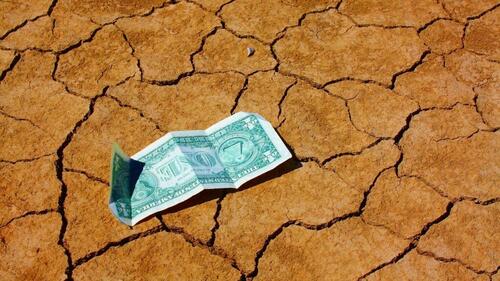
Incomes were up 0.5% month-on-month. That seems like a solid gain — until you factor in rising prices. According to the Personal Consumption Expenditure (PCE) index, prices were up 0.9% in March. That means real incomes were down 0.4%.
Looking at the bigger picture, incomes were up, but not nearly as much as prices. Once again, we see price increases eating up income gains and then some. That means your standard of living is falling.
The Federal Reserve loves the PCE. That’s because it is probably the most dishonest of all the government’s dishonest inflation measures. It is manipulated to understate rising prices. So, real incomes are falling even faster than the data indicates.
Peter Schiff pointed out that American consumers would be better off in incomes were down 0.5% and prices fell 0.9%. Rising wages aren’t helpful if prices go up even faster.
What counts is not how much you’re paid, but how much you can buy. It’s the difference between what you earn and what you spend that counts. So, if wages are falling, but prices are falling even more, that’s a good thing because workers are better off.”
As it is, you’re working more and earning more, but you’re falling further and further behind. Real wages are collapsing.
Personal spending blew away expectations in March. Spending was up 1.1%. But where did that big increase in spending come from? It didn’t come from higher wages. It came from savings. The savings rate fell to 6.2% in March, the lowest in nine years. Schiff said he thinks savings will hit an all-time low before the year is over.
Consumers are dipping into a very shallow saving pool to try to keep their economic necks above water as prices are going up.”
Americans are also running up their credit cards. Revolving credit, primarily credit card debt, rose by a whopping 20.7% in February. (the March data will be out in the next week or so.) American consumers added $18 billion to their credit card bills in February alone.
Mainstream pundits spun rising consumer spending as a sign of a strong economy. But with prices up 0.9%, real spending was only up 0.2% in March. And as Schiff points out, prices being only up 0.9% “is a fantasy.”
They’re up much more than that. And so, spending is actually down. People are buying less stuff. They’re just paying more for the stuff they’re buying. And because they’re paying so much more for food, and energy, and rent, and insurance, and stuff like that, they don’t have enough money left over to go shopping on Amazon, which is why Amazon reported such bad earnings.”
This is why Schiff says a significant recession is likely on the horizon.
2.LAWRIE WILLIAMS//,//Egon von Greyerz///Matthew Piepenburg via GoldSwitzerland.com, James RICKARDS/
LAWRIE WILLIAMS: Volatile month sees enormous swings in gold, silver and equities
Maybe the long-predicted equities crash has already begun, although a lower than anticipated Fed interest rate rise at this week’s FOMC meeting might result in something of a recovery, But, at the moment our warnings that rising inflation would likely be the principal market depressor is coming true – perhaps sooner than many had suspected. The Russian invasion of Ukraine has certainly helped raise market uncertainty and also contributed to the inflation rises by the indirect effects on the supply chain resulting from the war itself and to the effects, real and projected, of sanctions on Russian exports.
The table below looks at the performance over the past month of the major equity indexes, precious metals, oil, natural gas and the copper price – of all the base metals copper is considered the best guide to likely economic growth, or otherwise, ahead. As can be seen nearly all have been marked down in the past month and year to date – equities and bitcoin particularly so, but the major precious metals too certainly have not been immune in April apart from palladium, where Russia is the world’s No.1 exporter and sanctions impositions could severely disrupt deliveries.
We had anticipated that perhaps gold and silver would emerge from an equities meltdown relatively unscathed – particularly the former – but had also warned that liquidity needs could force some investors and funds to unload good assets along with bad ones to stay afloat. This happened the last time there was a serious market meltdown back in 2008, but gold investors should perhaps take comfort in that the yellow metal did recover quickly at that time and went on to attain new highs within the next 2-3 years. Gold is up a little year-to-date, but down in April and ended the month hugely below its March peak.

Markets have been nervous, though, ahead of the forthcoming U.S. Federal Open Market Committee (FOMC) meeting, which commences on Tuesday, at which the U.S. Federal Reserve will set out its likely more aggressive interest rate policy. The nervousness arises because even the widely predicted 50 basis point interest rate increase, likely to be followed by the prospect of another similarly- sized rise at the June FOMC meeting, coupled with the ending of the Fed’s bond and mortgage security-buying programmes (Quantitative Tightening or QT) could possibly see U.S. equities markets dive further.
U.S. businesses have become so used to several years of the Fed effectively supporting them with near-zero interest rates and with effectively pumping funds into the markets, that bringing all this to an abrupt end may provide a severe shock. Perhaps they should be glad that Fed chair Jerome Powell is unable to mete out the kind of medicine Paul Volcker did in 1979/80, which certainly defeated inflation but drove the U.S. economy into a deep recession. The current enormous debt level (estimated at around $30.4 trillion) the U.S. has built up has made the Volcker remedy, which saw interest rates rise to near 20%, financially untenable. The costs of servicing such a high debt level at this kind of interest rate would rapidly bankrupt the country.
April has thus been a particularly volatile month for both equities and metals with this combination of factors affecting the equities markets which mostly fell back – particularly in the past week despite a couple of recovery attempts. Indeed it has perhaps been surprising that there had not been even more market disruption earlier in the month given the potentially serious impact of the two principal driving forces which have come to the fore. The two are also connected in that the one is seriously affecting the other as well, as we noted above at the start of this article.
As a result, very few asset classes are still in positive territory this year. Gold is up a little under 4% since the end of December 2021, despite falling in price in April. It had seemed to be starting to improve Friday, but the core Personal Consumption Expenditure (PCE) inflation index, which is the Fed’s preferred measure, came in that day at a better than expected 5.2% annual increase and the gold price dipped back below $1,900 in later trade. The overall PCE, which includes food and energy prices, came in at a worrying 6.6% annual rate though, up another 0.3% on the previous month’s figure,
Palladium, for which Russia is comfortably the world’s largest producer, bucked the trend accordingly and was up nearly 14%, but was pretty much flat in April. Most base metals fell in price – even much-touted copper which is seen as something of a bellwether for the likely forward path of the economy.
Of the major stock indexes we have looked at most are down year-on-year, the only gainer being the FTSE 100 in the UK, which perhaps has benefited marginally from Brexit insulating it from some of the tribulations which have afflicted other European economies. The biggest gainer of all we have listed was natural gas, for which Russia provides around 40% of mainland Europe’s supply, where prices have risen over 95% year-to-date. Oil, where Russia is also a dominant exporter, particularly also to Europe, has risen in price by around 31.5%. Not surprisingly in view of these statistics, the increase in energy prices has been the most significant component in the global rise in inflation.
The two principal overall market drivers are, of course, rapidly rising global inflation and the Russian invasion of Ukraine. The first was already beginning to impact markets quite severely from late last year as nations were beginning to exit from the strictures which had been imposed to try and help control the spread of the Covid-19 pandemic.
The Ukraine war has not only created huge geopolitical uncertainty in Europe in particular, but has led to some extremely stringent economic sanctions being applied to the Russian economy to try and persuade President Putin to end his attacks on Ukraine, with seemingly little effect so far.
As Russia is a key global supplier of metal and energy commodities, foodstuffs and fertilizers, and Ukraine the latter two, the sanctions and war disruptions are having also an adverse effect on the economies of nations importing these products. Supplies are being cut off and need to be replaced by more expensive alternatives from elsewhere assuming these are even available. Even nations like the U.S., which are reasonably self-sufficient in most, but not all, areas are not immune from the inflationary pressures thus created.
The latest confirmation of the adverse effects of all this on the U.S. economy arose with the Bureau of Labor Statistics’ latest Consumer Price Index (CPI) and Producer Price Index (PPI) data announcements mid-month which came in at 8.5% and 11.2% year-on-year increases respectively, the worst for 40 years or more. The big worries here are what steps will the U.S. Fed take to try and bring these excessive inflation levels, which still seem to be rising, down to its target of around 2%.
The standard tools for combating inflation are to raise interest rates, and to cut back on any other accommodative bond and security-buying programmes. But the big problem facing the Fed is that interest rates have been ultra-low (near zero) for so long and although QT on its accommodative bond and mortgage security buying programs is already starting to be implemented, many economists consider it as being too little too late.
Even a succession of above-the-norm interest rate rises through the remainder of the year at the kinds of levels the Fed seems to be contemplating, continuing into next, may still be insufficient to even start to bring down inflation without also driving the U.S. economy sharply downwards. American businesses have become far too used to easy money flowing from the Fed into the markets and ultra-low interest rates supporting them. This has seen equity markets rise to levels which many consider unsustainable. Some well- respected commentators are even predicting a serious recession within the next couple of years – or perhaps sooner. The recent sharp equity price falls suggest it may have even already begun despite occasional partial recoveries. And as the world’s leading economy, what happens in the U.S. tends to set the pattern elsewhere in the world.
The resurgence of the Covid-19 pandemic in China, resulting in draconian measures to try and keep it under control, is also contributing to supply-chain worries and further resultant inflation fears. This has been having an additional adverse impact on the markets.
In theory – in the writer’s opinion at least – the markets should be far more worried about inflation and potential Fed moves to bring it down than they appear to have been up until the past few days. Such moves could see Federal Fund interest rate levels raised at a faster rate than at any time in the past three to four decades. There is even talk of a 75 basis point rate increase being imposed at the forthcoming FOMC meeting, although the consensus opinion is still for the 50 basis point rise as suggested by Fed chair Jerome Powell. But even this could be high enough to put an additional serious dent in equity market valuations, particularly if the Fed forecasts more of the same medicine to come during the remainder of the year, and beyond, which seems distinctly possible. Equity investors in particular should perhaps be prepared for a difficult few months, if not years, ahead.
01 May 2022
-END-
3. Chris Powell of GATA provides to us very important physical commentaries
Nabiullina is still western trained. There is a differing of opinion linking the rouble to gold with the Krelim saying one thing and the central bank chief another.
(Bloomberg/GATA)
Russian central bank chief rejects linking ruble to gold, differing with Kremlin
Submitted by admin on Fri, 2022-04-29 11:47Section: Daily Dispatches
From Bloomberg News
Friday, April 29, 2022
Bank of Russia Governor Elvira Nabiullina today dismissed the idea of pegging the ruble to gold after the Kremlin said it was a proposal under consideration.
“It is not being discussed in any way,” Nabiullina told reporters at a briefing after the central bank cut the key interest rate by 300 basis points.
The ruble must continue to have a floating exchange rate, she said, though volatility of the currency will be higher amid capital controls imposed after Russia began its invasion of Ukraine
Her comment appeared to contradict President Vladimir Putin’s spokesman, Dmitry Peskov, who said earlier today that “this question is now being discussed.” Peskov pointed to comments by Security Council Secretary Nikolai Patrushev on linking the currency to gold and other commodities in an interview with a state-run newspaper this week, while offering no further details. …
… For the remainder of the report:
END
Interesting read on what one Chinese official believes:
Ambrose Evans Pritchard
(London Telegraph..GATA)
Ambrose Evans-Pritchard: China faces double disaster, caught between virus and Putin
Submitted by admin on Fri, 2022-04-29 12:36Section: Daily Dispatches
By Ambrose Evans-Pritchard
The Telegraph, London
Friday, April 29, 2022
China should abandon all illusions that the West is in terminal decline, or that a new world order of authoritarian regimes is dawning.
It should ditch Vladimir Putin immediately. The country should not be tainted by the retrograde adventurism of a loser. Beijing should instead seek a new concordat with Washington, acting as a conciliatory stakeholder power.
So concluded a sizzlingly cogent essay by Chinese foreign policy guru Hu Wei in March after Russia’s blitzkrieg failed to take Kyiv. Prof Hu heads the Shanghai Public Policy Research Institute, linked to reformers at the State
The essay circulated for several days in China before being expunged, a sign of powerful dissent against the pro-Putin policies of President Xi Jinping. The Carter Centre ran an English version.
Prof Hu says the Ukraine war will be a watershed moment, but not in the way that Xi imagined when he issued his Sino-Russia manifesto for the new world order in February, proclaiming “no limits” to China’s bond with Putin’s Russia — the green light for the invasion of Ukraine.
“The power of the West will grow significantly, NATO will continue to expand, and U.S. influence in the non-Western world will increase,” said Prof Hu.
“The West will possess more ‘hegemony,’ both of military power and in terms of values and institutions; its hard power and soft power will reach new heights.”
He even expects a resurrection of Francis Fukuyama’s Hegelian dream of democratic liberalism as the end-state for mankind, though Fukuyama himself (spooked by Trump) has since lost faith in the End of History.
Xi ignored the warnings and now faces a grave strategic reverse. …
… For the remainder of the analysis:
https://www.telegraph.co.uk/business/2022/04/29/china-faces-double-disaster-caught-covid-putin/
end
this is a must view
Andrew Maguire and Alasdair Macleod at the vault:
(Kinesis/GATA)
Maguire and Macleod discuss defections from Western financial system
Submitted by admin on Fri, 2022-04-29 23:09Section: Daily Dispatches
11:08p ET Friday, April 29, 2022
Dear Friend of GATA and Gold:
London metals trader Andrew Maguire interviews GoldMoney research director Alasdair Macleod on this week’s edition of Kinesis Money’s “Live from the Vault” program, discussing the defection of China, Russia, and other countries from the Western financial system.
Macleod and Maguire see a “commodification” of currencies as the Western system collapses, leading to a revaluation of gold.
The discussion is 57 minutes long and can be seen at YouTube here:
CHRIS POWELL, Secretary/Treasurer
Gold Anti-Trust Action Committee Inc.
CPowell@GATA.org
END
The rise in the USA dollar( % this year) is leading to a huge trail of destruction
(Reuters/GATA)
Dollar’s surge leaves a trail of destruction
Submitted by admin on Fri, 2022-04-29 23:20Section: Daily Dispatches
By Saikat Chatterjee and Sujata Rao
Reuters
Friday, April 29, 2022
LONDON — The dollar’s race to two-decade highs is leaving a trail of destruction in its wake, exacerbating inflation in other countries and tightening financial conditions just as the world economy confronts the prospect of a slowdown in growth.
This year’s 8% gain by the dollar against a basket of currencies is driven partly by bets that the U.S. Federal Reserve will raise interest rates faster and further than other developed countries, and partly by its status as a safe haven in times of turbulence
.It is also supported by Japan’s reluctance to ditch its super-easy policies, and fears of recession in Europe.
Here are some areas affected by the dollar’s muscle-flexing. …
… For the remainder of the report:
https://www.reuters.com/business/dollar-surge-leaves-trail-destruction-2022-04-29/
end
Stress beginning to emerge in treasuries with collateral fails
(Dizard/London’s Financial Times)
Stress emerges again in Treasuries market
Submitted by admin on Sat, 2022-04-30 20:09Section: Daily Dispatches
By John Dizard
Financial Times, London
Saturday, April 30, 2022
When the world’s biggest and most liquid market shows signs of stress, investors should take note.
At the beginning of this month, major financial market participants trading in the U.S. Treasury bond market had difficulty meeting the demands for collateral made by their counterparties.
The alarm bell was reported in the Federal Reserve Bank of New York’s Primary Dealer Statistics, in the weekly report for “fails” for U.S. Treasury securities. A “fail” occurs when a market participant breaks a promise to receive or deliver securities when they are obliged to do so.
In the week ended April 6, there were a total of $507 billion in fails reported by the primary dealers, a sharp rise from $358 billion in the previous week ended March 30. The level fell back down again to $275 billion in the subsequent week and was far below the $5.3 trillion peak of fails seen in one October week in the 2008 financial crisis.
But the jump this month was notable — the highest level of fails since March 2020.
During that March, you will recall, financial markets very publicly ground to a halt due to Covid-19 lockdowns. This time, though, there was no particular, visible trigger event. …
… For the remainder of the analysis:
https://www.ft.com/content/0ecb9244-46e8-4feb-b4c2-d9b277140d4f
end
4.OTHER GOLD/SILVER COMMENTARIES
5.OTHER COMMODITIES PALM OIL
end
COMMODITIES IN GENERAL//DIAMONDS
END
6.CRYPTOCURRENCIES
7. GOLD/ TRADING
Your early currency/gold and silver pricing/Asian and European bourse movements/ and interest rate settings MONDAY morning 7:30 AM
ONSHORE YUAN: CLOSED DOWN 6.6085
OFFSHORE YUAN: 6.6747
HANG SANG CLOSED
2. Nikkei closed DOWN 29.37 PTS OR 0.11%
3. Europe stocks ALL CLOSED
USA dollar INDEX UP TO 103.43/Euro FALLS TO 1.0523
3b Japan 10 YR bond yield: RISES TO. +.224/ !!!!(Japan buying 100% of bond issuance)/Japanese yen vs usa cross now at 129.96/JAPANESE FALLING APART WITH YEN FALTERING AS WELL AS LONG TERM YIELDS RISING BREAKING THE JAPANESE CENTRAL BANK.
3c Nikkei now ABOVE 17,000
3d USA/Yen rate now well below the important 120 barrier this morning
3e Gold DOWN /JAPANESE Yen DOWN CHINESE YUAN: UP -SHORE CLOSEDDOWNP// OFF- SHORE DOWN
3f Japan is to buy the equivalent of 108 billion uSA dollars worth of bond per month or $1.3 trillion. Japan’s GDP equals 5 trillion usa./“HELICOPTER MONEY” OFF THE TABLE FOR NOW /REVERSE OPERATION TWIST ON THE BONDS: PURCHASE OF LONG BONDS AND SELLING THE SHORT END
Japan to buy 100% of all new Japanese debt and by 2018 they will have 25% of all Japanese debt. Fifty percent of Japanese budget financed with debt.
3g Oil DOWN for WTI and DOWN FOR Brent this morning
3h European bond buying continues to push yields lower on all fronts in the EMU. German 10yr bund RISES TO +.0.918%/Italian 10 Yr bond yield RISES to 2.81% /SPAIN 10 YR BOND YIELD RISES TO 1.98%…ITALIAN 10 YR BOND YIELD/GERMAN BUND: 1.89: DANGEROUS FOR THE ITALIAN BANKING SYSTEM
3i Greek 10 year bond yield RISES TO : 3.36
3j Gold at $1874.50 silver at: 22.62 7 am est) SILVER NEXT RESISTANCE LEVEL AT $30.00
3k USA vs Russian rouble;// Russian rouble UP 0 roubles/dollar; ROUBLE AT 70.96
3m oil into the 101 dollar handle for WTI and 104 handle for Brent/
3n Higher foreign deposits out of China sees huge risk of outflows and a currency depreciation. This can spell financial disaster for the rest of the world/
JAPAN ON JAN 29.2016 INITIATES NIRP. THIS MORNING THEY SIGNAL THEY MAY END NIRP. TODAY THE USA/YEN TRADES TO 129.96 DESTROYING JAPANESE CITIZENS WITH HIGHER FOOD INFLATION
30 SNB (Swiss National Bank) still intervening again in the markets driving down the FRANC. It is not working: USA/SF this morning .9739– as the Swiss Franc is still rising against most currencies. Euro vs SF 1.0248well above the floor set by the Swiss Finance Minister. Thomas Jordan, chief of the Swiss National Bank continues to purchase euros trying to lower value of the Swiss Franc.
USA 10 YR BOND YIELD: 2.918 UP 3 BASIS PTS
USA 30 YR BOND YIELD: 2.989 UP 3 BASIS PTS
USA DOLLAR VS TURKISH LIRA: 14.88
Futures Struggle To Rebound With Fed Set To Hike 50 Into A Recession
MONDAY, MAY 02, 2022 – 07:54 AM
One trading day after epic carnage shook global markets, US index futures staged a modest recovery on Monday after Wall Street’s worst selloff in almost two years. S&P 500 Index contracts rose 0.1% from an 11-month low, while Nasdaq 100 futures gained 0.4% with volumes thinned by holidays in several markets including the UK, China and Hong Kong. European and Asian stocks fell as disappointing corporate earnings, expectations of global monetary tightening, poor data from China and the prospect of sanctions on Russian oil weighed heavily on risk appetite. The VIX remained elevated, trading above 33, as investors braced for a week that’s likely to see a global round of monetary-policy tightening that will add to concerns about global growth. 10Y Treasury yields pushed higher again, rising to 2.94% before easing ahead of this week’s key event, the Fed’s upcoming 50bps rate hike. The dollar gained as worries over high inflation and China’s Covid lockdowns contributed to investor caution, and sent the offshore yuan sliding to just shy of 6.69m the lowest since November 2020. Gold extended its slump and Brent oil dropped about $2 to trade around $104.50.
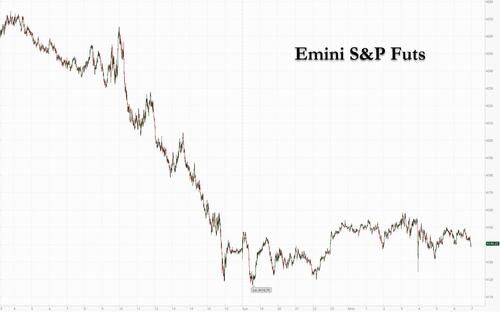
Focus has shifted back to the Fed’s policy outlook after last Friday’s pledge by China to boost economic stimulus damped demand for havens on Friday. The week’s main event will take place on May the 4th (be with you), when the Fed is expected to lift rates by 50bps, the first “double-hike” since May 2000, and will announce it will let its balance sheet start to shrink at a pace that will quickly step up to $95 billion a month. Odds of 75bps rate hike in June remain at 50%. Bond yields may stay “elevated for the foreseeable future” due to inflation and the Fed’s sharp rate hikes allied with balance-sheet reduction, Seema Shah, chief global strategist at Principal Global Investors, wrote in a note. Japanese institutional managers – known for their legendary U.S. debt buying sprees in recent decades – are now fueling the great bond selloff just as the Federal Reserve pares its $9 trillion balance sheet.
In premarket trading, Activision Blizzard gained 2% after Warren Buffett snapped up more of the stock in a merger arbitrage bet (yes, Berkshire is a merger-arb powerhouse now, how long until Berkshire does Twitter). Here are some other notable movers:
- Comerica (CMA) upgraded to overweight and KeyCorp (KEY) cut to underweight at Piper Sandler as the broker shuffled ratings to reflect its post-earnings preferences
- Piper Sandler analyst Alexander Twerdahl cut the recommendation on Community Bank System (CBU) to underweight, becoming the first broker to downgrade the company with a sell-equivalent rating since July 2020
- Piper Sandler analyst Arvind Ramnani raised the recommendation on Epam Systems (EPAM) to overweight, citing healthy demand for digital IT services
In Europe, the automotive and tech sectors led the Stoxx Europe 600 Index down 1%, extending its losses this year to 8.6% with focus on the potential for the European Union to propose a ban on Russian oil by year-end as well as concerns over China’s economy. Vestas fell 5.9% in Copenhagen after the Danish maker of wind turbines cut its revenue outlook for the full year and forecast its first loss in a decade. Confidence in the euro-area economy fell to the lowest in a year as the impact of the war in Ukraine drained overall sentiment from industry to consumers.
Among individuals moves in Europe, Adler Group SA shares plunged more than 40% after KPMG said it was unable to give an audit opinion and Vestas Wind Systems A/S slumped after forecasting its first loss in a decade.
Earlier in the session, Asian stocks slid on delayed reaction to the Friday carnage after underwhelming earnings guidance from U.S. tech giants fueled worries about a further slowdown in a global economy already smarting from the Federal Reserve’s policy tightening and China’s lockdowns to curb the coronavirus. The MSCI Asia Pacific Index dropped as much as 0.8%, weighed down by losses in financials and technology. The key gauge in Australia fell the most ahead of Tuesday’s local central bank policy meeting that is expected to raise rates for the first time since 2010.
Markets in China, Hong Kong, Taiwan and Singapore were closed for holidays. Chinese economic activity contracted sharply in April, data released Saturday showed, weighing on regional investor sentiment even after the Politburo pledged to meet economic targets. Fed Chair Jerome Powell has as good as promised that U.S. officials will deliver a 50 basis-point interest-rate increase this week.
“The U.S. economy appears to be peaking while markets expect almost four 50-basis-points rate hikes by the Federal Reserve in upcoming policy meetings,” said Norihiro Fujito, chief investment strategist at Mitsubishi UFJ Morgan Stanley Securities. “China’s PMI announced over the weekend was terrible. When you have the world’s two largest economies in conditions like this, there will be pressure on corporate earnings.”
Asian tech stocks were weak after Amazon.com Inc. plunged on Friday by the most since 2006 on a sales forecast that fell short of analyst estimates. IPhone maker Apple Inc. warned last week of a hit of up to $8 billion in its second-quarter revenue as China’s Covid-19 lockdowns undermine the world’s supply lines
Japanese equities fell slightly ahead the Federal Reserve’s planned interest-rate hike this week and amid continued concern over the impact of China’s lockdowns to curb the coronavirus. Japanese markets will be closed Tuesday through Thursday for Golden Week holidays. The Topix fell 0.1% to close at 1,898.35 Monday, while the Nikkei declined 0.1% to 26,818.53. Nintendo Co. contributed the most to the Topix decline, decreasing 2.4%. Out of 2,172 shares in the index, 1,110 rose and 973 fell, while 89 were unchanged.
India’s key equity gauges fell on Monday, dragged by information technology stocks and index heavyweight Reliance Industries while corporate earnings performance for March quarter remains mixed. The S&P BSE Sensex fell 0.2% to 56,975.99 in Mumbai, while the NSE Nifty 50 Index also retreated by an equal measure. The key gauges fell 2.6% and 2.1% in April, respectively and have retreated in three of four months this year. Indian markets will be shut on Tuesday due to a local holiday. Ten of the 19 sector sub-indexes compiled by BSE Ltd. declined, led by consumer durables. Metal and basic material companies were the best performers.
Foreign investors, who have been net sellers of Indian stocks since end of September, dumped about $3.4 billion in month through April 28. The global funds have sold a total of $21.7 in the preceding 7 months as surging inflation and a war in Ukraine dented global risk-appetite for equities. Infosys contributed the most to the index decline, decreasing 1.7%. Out of 30 shares in the Sensex index, 11 rose and 19 felf.
In rates, Treasuries reopened slightly richer across the curve when trading resumed following holiday closures across Europe. 10-year TSY yields were around 2.915% is richer by ~2bp vs Friday’s close, vs 2.5bp for German 10-year. U.S. 10-year sector slightly outperforms front-end where 2-year yields are lower by 1bp on the day; curve spreads remain within ~1bp of last week’s close. Bunds outperform with gilts closed for U.K. bank holiday. Dollar issuance slate empty so far; estimates for the week are around $25b, and some expect a historically busy month with $125b-$150b of IG credit supply.
In FX, a gauge of the dollar’s strength advanced, outperforming most other Group-of-10 currencies. Trading volumes thinned with holidays in countries including the U.K. China’s manufacturing and services activity plunged to their worst levels since February 2020, according to purchasing managers surveys. The Bloomberg Dollar Spot Index gains 0.1%; cash Treasuries are closed until U.S. hours. “There’s a good chance that we would go towards parity in euro-dollar,” Union Investment’s Christian Kopf said in an interview with Bloomberg Television on Monday. Elsewhere, the yen underperformed all its G-10 peers/ The Australian and New Zealand dollars dropped amid momentum selling and liquidation of longs by leveraged funds, traders said. “As long as the Fed doesn’t blink, the dollar stays bid,” ING Groep NV analysts including Chris Turner wrote in a note. The offshore yuan weakened in the wake of data signaling a sharp contraction in Chinese economic activity amid idled factories and snarled supply chains.
In commodities, WTI and Brent fell with downside occurring alongside the pressure in equities; downside was exacerbated by the loss of multiple psychological support levels. Newsflow has been heavily focused on a potential Russian oil/gas embargo, with Hungary remaining heavily opposed; however, Politico reports of a potential compromise for such member nations.
A missile attack on an oil refinery in Iraq’s Erbil hit an oil tank and caused a fire although the fire was put under control, according to Reuters citing security forces. Iraq’s oil exports reached a total of 101mln bbls in April which raised USD 10.55bln in revenues, while exports averaged 3.4mln bpd.
Bitcoin prices are marginally higher and rebounded from beneath the 38,500 level.
Looking at today’s calendar, we get the April manufacturing PMI and US ISM Manufacturing data, new car registrations, US March construction spending. We also get earnings from NXP Semiconductors, Devon Energy, Expedia, MGM resorts, SolarEdge.
Market Snapshot
- S&P 500 futures down 0.1% to 4,125.75
- STOXX Europe 600 down 1.4% to 444.02
- MXAP down 0.6% to 167.87
- MXAPJ down 0.6% to 556.31
- Nikkei down 0.1% to 26,818.53
- Topix little changed at 1,898.35
- Hang Seng Index up 4.0% to 21,089.39
- Shanghai Composite up 2.4% to 3,047.06
- Sensex down 0.5% to 56,783.95
- Australia S&P/ASX 200 down 1.2% to 7,346.99
- Kospi down 0.3% to 2,687.45
- German 10Y yield down 3bps to 0.91%
- Euro down 0.2% to $1.0526
- Brent futures down 2.6% to $104.32/bbl
- Gold spot down 0.8% to $1,881.25
- U.S. Dollar Index up 0.41% to 103.38
Top Overnight News from Bloomberg
- A gauge of the dollar advanced as traders positioned for the Federal Reserve to deliver its biggest rate hike since 2000 this week.
- Australian bonds sold off as investors anticipate the nation’s central bank will raise interest rates on Tuesday for the first time since 2010.
- In times of Treasury turmoil, the biggest investor outside American soil has historically lent a helping hand. Not this time round.
- Oil slipped at the start of the month as investors weighed the impacts of China’s measures to contain the coronavirus and moves by Europe to cut its reliance on fuel from Russia
- In times of Treasury turmoil, the biggest investor outside American soil has historically lent a helping hand. Not this time round
- China’s factory activity fell to the lowest level in more than two years in April, underscoring the economic damage caused by Covid outbreaks and lockdowns and escalating concerns about further disruption to global supply chains
- A widespread sell-off in China is rippling through emerging markets, threatening to snuff out growth and drag down everything from stocks to currencies and bonds
A more detailed look at global markets courtesy of Newsquawk
Asia-Pac stocks declined amid mass holiday closures, weak Chinese PMIs and upcoming key risk events including central bank meetings. ASX 200 underperformed with all sectors pressured as yields edged higher ahead of an expected rate lift-off by the RBA tomorrow. Nikkei 225 was subdued after stalling on approach to the 27,000 level and with participants tentative ahead of a three-day closure. Hang Seng and Shanghai Comp remained shut due to Labour Day holidays but will reopen on Tuesday and Thursday, respectively.
Top Asian News
- Billionaire Cannon-Brookes to Seek Stake in Australia’s AGL
- Asian Factories Defy China Slowdown as Euro Area Loses Momentum
- Marcos Jr. Keeps Lead Ahead of Philippine Presidential Poll
- Australia Yields Hit Highest Since 2014 With RBA, Fed Hikes Seen
European bourses are lower across the board, Euro Stoxx 50 -1.60%, following a subdued APAC handover amid holiday thinned conditions, soft data and COVID concerns. US futures are firmer across the board, ES +0.3%, but relatively contained ahead of the FOMC and an expected 50bp hike. US and Japan are to increase cooperation in constructing supply chains for cutting-edge semiconductors, via Nikkei. Nasdaq has decided to call for stressed market conditions on all Swedish equity and index derivatives until further notice or at the longest until close of business as of May 2, 2022.
Top European News
- Deutsche Bank AGM Shouldn’t Absolve Leaders, Advisor Says
- Spanish Prime Minister’s Phone Hacked With Spy Software in 2021
- Credit Suisse Falls Most in 2 Months; Outpaces Drop in Swiss SMI
- Partners Group Declines 9.3%, Most in Two Years
FX :
- Specs add to Buck longs before FOMC and NFP, but DXY slips a tad further from 103.930 peak into range above the round number – index meandering from 103.530-100.
- Euro hampered by mixed Eurozone manufacturing PMIs and weaker than forecast sentiment indices as it retreats from 1.0550+ and 0.8400+ vs Dollar and Sterling respectively.
- Recoil in oil undermines Loonie and Norwegian Crown, USD/CAD elevated mostly above 1.2850 and EUR/NOK 9.9000+.
- Aussie underpinned ahead of anticipated RBA hike, AUD/USD straddling 0.7050 and AUD/NZD cross pivoting 1.0950.
- Offshore Yuan weak amidst clean sweep of contractionary Chinese PMIs, USD/CNH not far from retest of 6.7000.
Fixed Income:
- Holiday-thinned trading volumes compound choppy price action as bonds brace for big week to begin May.
- Bunds whipsaw within 154.12-153.25 range, BTPs and Bonos undermined by sub-forecast Italian and Spanish PMIs with 10 year debt futures flattish between 130.71-129.71 and 143.05-140.50 parameters.
- USTs mostly softer and curve steeper awaiting Fed and NFP following the final manufacturing PMI, ISM and construction spending; T-note just under 119-00 vs 119-01 high and 118-22+ low.
Commodities:
- WTI and Brent are pressured with downside occurring alongside the pressure in equities; downside was exacerbated by the loss of multiple psychological support levels.
- Newsflow has been heavily focused on a potential Russian oil/gas embargo, with Hungary remaining heavily opposed; however, Politico reports of a potential compromise for such member nations.
- A missile attack on an oil refinery in Iraq’s Erbil hit an oil tank and caused a fire although the fire was put under control, according to Reuters citing security forces.
- Iraq’s oil exports reached a total of 101mln bbls in April which raised USD 10.55bln in revenues, while exports averaged 3.4mln bpd. It was also reported that Iraq’s Basra Oil Company said a third oil pipeline at the Khor Al-Amaya oil terminal in southern Iraq will be operational by end-2023 with a capacity of 600k bpd, according to Reuters.
- Libya’s NOC announced a temporary resumption of work and lifting of the force majeure at the Zueitina oil terminal to reduce stock and free up storage capacity, according to Reuters.
- Spot gold has lost the USD 1900/oz mark, as yields continue to climb ahead of the FOMC.
US Event Calendar
- 09:45: April S&P Global US Manufacturing PMI, est. 59.7, prior 59.7
- 10:00: March Construction Spending MoM, est. 0.8%, prior 0.5%
- 10:00: April ISM Manufacturing, est. 57.6, prior 57.1
- April ISM Employment, est. 55.0, prior 56.3
- April ISM Prices Paid, est. 87.4, prior 87.1
- April ISM New Orders, est. 54.1, prior 53.8
DB’s Jim Reid concludes the overnight wrap
Filling in on the May Day bank holiday as we enter a new month. Despite the holiday, the industrious Henry Allen on our team has put out the April month asset performance review, link available here. The US dollar was among the best performing assets on the month, following the Fed’s anticipated supercharged tightening combined with fluttering risk sentiment, making it the top performing G10 currency YTD. Elsewhere, brent and WTI crude gained for the fifth month in a row, the latest run aided by growing speculation that Europe is prepared to countenance Russian energy embargos. Agricultural goods rounded out the top performers. On the downside, equities and sovereign bonds both lost ground over the month, with the S&P 500 posting its worst monthly return since covid seized markets in March 2020. Credit and EM assets were also down over the volatile month.
From the month gone to the packed week ahead. The highlight is Wednesday’s FOMC meeting, which our US economics team has previewed in full, here. They believe the Fed will kick tightening up a notch, lifting the fed funds target range by +50bps. The market agrees, and then some, with +51.8bps of tightening priced for the meeting, suggesting some market participants believe there’s still some risk of an even larger hike. Our US econ team believes the Chair will signal this is but the first of a series of potential +50bp hikes, as the Fed tries to get policy to neutral as quickly as possible in light of historic inflation. With the question of how fast the Fed needs to raise rates generally understood (answer: very), focus will shift to how far they need to hike rates to tighten financial conditions adequately.
That task will be augmented by balance sheet rundown, as the Fed has also signaled they will announce the beginning of QT, with the first assets likely rolling off the Fed’s portfolio in June. Our estimates are that QT will proceed through next year, adding around three additional +25bp hikes of tightening, only to stop once the economy careens into recession at the end of 2023.
The BoE is similarly expected to raise rates and signal tighter balance sheet policy on Thursday. Our UK economist full preview can be found here. The team expects the MPC to continue wrestling with the trade-off between slowing growth and intensifying inflation, with the latter winning out and bringing a +25bp Bank Rate hike, along with two more hikes coming this year. On the balance sheet, our team thinks the MPC will confirm its intention to sell gilts later this year, with more guidance coming over the next few meetings and sales beginning in September.
There’s no rest for the weary, as the week ends with the US employment situation report, where our US economists expect nonfarm payrolls to gain +465k, the unemployment rate to tick down to +3.5%, and average hourly earnings to gain +0.2%. Unemployment figures from Europe are also due this week. Production data, starting with ISM manufacturing out later today, also feature this week.
After last week’s mega-cap deluge, this week’s earnings are a sample platter drawing from travel, hospitality, and energy firms.
Available Asian stock markets are trading lower after China’s downbeat PMI data released over the weekend is weighing on the regional investor sentiment. The Nikkei (-0.53%), Kospi (-0.60%) are both trading in negative territory.
The Chinese official manufacturing PMI for April worsened to a level of 47.4 (v/s 49.5 in March), a second straight month of contraction and notching its lowest level since February 2020 as the nation has been severely challenged by the resurgence of Covid-19, leading some firms to reduce or halt production. Additionally, the official non-manufacturing segment slumped by 6.5 percentage points to a level of 41.9 in April, with 19 of the 21 sectors surveyed in the contraction range. Also, a private survey also showed further deterioration in Chinese factory activity with the Caixin manufacturing PMI for April coming in at 46.0, declining from 48.1 in March. This follows last week’s reports that President Xi vows to step up government support in response to the slowdown.
Wrapping up last week’s action. The intensification of China’s lockdowns to stanch the most recent covid outbreak pushed the offshore renminbi -1.72% lower (+0.27% Friday) against the US dollar. The anticipated slowdown in Chinese activity drove global growth fears, prompting cross-asset volatility as investors layer in slower growth into the anticipated central bank reaction function.
US equity volatility reached levels not seen since Russia’s initial invasion of Ukraine, with the Vix picking up +5.18pts to 33.39 (+3.41pts Friday). The macro backdrop interacted with mega-cap tech earnings which painted a mixed outlook, that saw the S&P 500 down -3.27%, a full-3.63% lower on Friday’s month end trading. The STOXX 600 proved more resilient, retreating just -0.64% (+0.74% Friday).
Crude oil prices started the week lower on global demand fears, but eventually recovered following tensions around Russian energy exports to Europe ratcheting higher. Brent crude finished the week +6.92% higher (+1.63% Friday) at $109.34/bbl.
In data, the US employment cost index increased +1.4% versus +1.1% expectations, while core PCE gained +0.3% month-over-month, in line with expectations. Nominal 10yr Treasury yields were up a relatively tame +3.5bps over the week, but the on net figure masks intraweek volatility. 10yr yields were -18.8bps lower intraweek on the growth fears, before selling off more than +11bps on both Wednesday and Friday to finish the week. 10yr bunds were -3.4bps lower over the week (+3.8bps Friday), after hitting much lower troughs as well. Italian spreads widened +14bps to +184bps over 10yr bunds.
3. ASIAN AFFAIRS
i)MONDAY MORNING// SUNDAY NIGHT
SHANGHAI CLOSED XX PTS OR XX% //Hang Sang CLOSED XX OR XX% /The Nikkei closed DOWN 29.37 PTS OR 0.11% //Australia’s all ordinaires CLOSED DOWN 1.31% /Chinese yuan (ONSHORE) closed DOWN 6.6084 /Oil DONW TO 101.69 dollars per barrel for WTI and UP TO 104.10 for Brent. Stocks in Europe OPENED MOSTLY CLOSED // ONSHORE YUAN CLOSED DOWN AGAINST THE DOLLAR AT 6.6064 OFFSHORE YUAN CLOSED DOWN ON THE DOLLAR AT 6.6747: /ONSHORE YUAN TRADING ABOVE LEVEL OF OFFSHORE YUAN/ONSHORE YUAN TRADING WEAKER AGAINST US DOLLAR/OFFSHORE WEAKER//
3 a./NORTH KOREA/ SOUTH KOREA
///NORTH KOREA
END
3B JAPAN
Japan emerges as the biggest driver behind the recent surge in treasury yields.
(zerohedge)
Japan Emerges As Biggest Driver Behind Recent Surge In Treasury Yields
MONDAY, MAY 02, 2022 – 02:43 PM
It was about a year ago, when the calendar was moving from the end of the first quarter of 2021 and into the second quarter, when we first observed something unexpected about the single biggest catalyst behind the forceful emergence of the “reflation trade” in the first quarter, which many interpreted as markets pricing in higher long-term inflation and strong growth. Yet in reality as we reported last year, the move which coincided perfectly with the end of Japan’s fiscal year on March 31..

… was largely, if not exclusively, a byproduct of Japan’s giant pension fund, the GPIF, drastically shifting out of treasuries as it slashed its US Treasury exposure by a record amount.
This left to a blow out in yields, which also coincided with that infamous “failed” 7Y auction in Feb 2021, and was extremely material as most investors mistook the rise in yields as validation for a super-hot economy, and the consensus bought into the idea that 10-year yields were headed above 2%. Of course, as we cautioned investors, yields had overshot relative to the economic reality and over the coming weeks, economic data in the US couldn’t keep up with unrealistic expectations, and 10-year yields started grinding lower (similar to what we expect will happen in the next few months as the market realizes that the US is sliding into recession).
We bring this up because a bout a month ago we speculated that Japan was engaging in another wholesale liquidation of US paper ahead of (and following) its fiscal year end on March 31, with potentially huge false signal consequences…
… this has been confirmed and as Bloomberg writes overnight, Japanese institutional managers – best known for their legendary U.S. debt buying sprees in recent decades – are fueling the great bond selloff just as the Federal Reserve pares its $9 trillion balance sheet.
Validating our hypothesis that Japan is behind the great Treasury rout for the second year in a row, the latest data from BMO Capital Markets shows the largest overseas holder of Treasuries offloaded almost $60 billion over the past three months! And while that may be small change relative to the Japan’s $1.3 trillion stockpile, its effect is magnified by the near record illiquidity in the Treasury market.
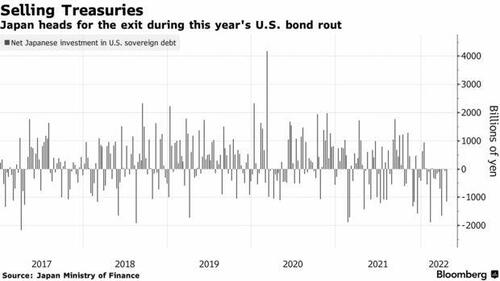
“It’s a significant amount of selling and on par with what we saw in early 2017 from Japan,” said BMO rates strategist Ben Jeffery.
Furthermore, the divestment threatens to grow because the monetary path between the U.S. and the Asian nation is diverging ever more, the yen is plumbing 20-year lows and market volatility stateside is breaking out, something Albert Edwards discussed in debt last weekend (see here). As we discussed last week, while the aggressive Fed tightening cycle to combat inflation could result in multiple 50 basis-point hikes in the coming months, the Bank of Japan remains locked in endless stimulus. That’s weakening the yen and upending the economics of buying Treasuries especially since the BOJ last week confirmed that the 10-year Japanese government bond will remain indefinitely capped around 0.25%, even if it means the total collapse of the yen.
This historic monetary policy decoupling is ramping up currency-hedging costs and completely offsetting the appeal of higher nominal U.S. yields, especially among large life insurers. As shown in the chart below, the cost of currency hedged Treasurys is the highest in two years, making it uneconomical for Japanese buyers to buy hedged TSYs, even with 10Y yields approaching 3%.

In fact, near-zero-yielding bonds at home look ever-more appealing even as U.S. debt offers some of the highest rates in years.
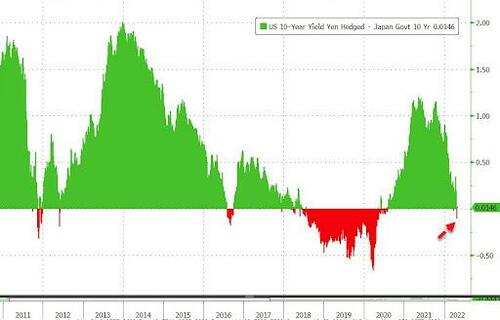
It means that while Japanese accounts are contributing to the historic Treasury rout, they may not return en masse until the benchmark 10-year yield trades firmly above 3%… which it did earlier today.
While 10-year U.S. yields briefly traded above 3% today for the first time since 2018, buyers who pay to protect against fluctuations in the yen-dollar exchange rate see their effective yields dwindle to just 1.3%. That’s because as shown above, hedging costs have ballooned to 1.66%, a level not seen since early 2020 when the global demand for dollars spiked in the pandemic rout.
Remarkably, a year ago the Treasury benchmark was offering a similar hedged yield, when the cost of protecting against moves in the exchange rate thanks to a modest 32 basis-point hedging expense.
“Hedge costs are the issue for investing in U.S. Treasuries,” said Eiichiro Miura, general manager of the fixed-income department at Nissay Asset Management Corp.
Worse, while Fed tightening and associated market volatility, have tempered Japanese buying of Treasuries in the past, in this cycle, the high level of uncertainty surrounding U.S. inflation and interest-rate policy may trigger an extended absence according to Bloomberg.
At the same time, Japanese traders have other, far more lucrative hedged offshore options as euro-hedging costs remain near the one-year average: “In the span of next six months or so, investing in Europe is better than the U.S. as hedge costs are likely to be low,” said Tatsuya Higuchi, executive chief fund manager at Mitsubishi UFJ Kokusai Asset Management Co. “Among the euro bonds, Spain, Italy or France look appealing given the spreads.”
“The Fed is being super aggressive,” said John Madziyire, portfolio manager at Vanguard Group Inc. “Are you really going to buy when Treasuries will probably get to more attractive levels?”
One broad Treasury index is already sitting on a more than 8% loss so far this year. Much now rests on whether the 10-year can consolidate in a range of 2.80% to 3.10% this month once the upcoming Fed meeting is absorbed by the market along with quarterly debt sales from the U.S. Treasury.
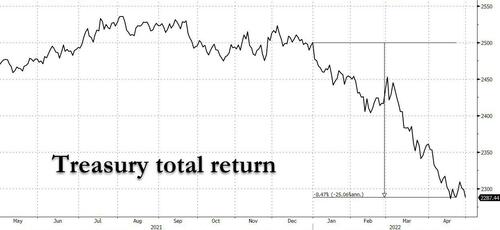
“Japanese investors will wait for some stabilization in long-dated yields before they sense a buying opportunity,” said George Goncalves, head of macro strategy at MUFG. “If the 10-year settles during May, that will help attract buyers and at those yield levels you are getting compensated now.”
As for how messed up the market signaling may be due to Japan’s forced selling, and the market’s interpretation that – just like in 2021 – the US economy is getting stronger and able to accommodate Fed rate hikes when in fact the spike in yields is just a function of, well, forced selling, we hope to find out in a few months when the Fed will have hiked 50gps and maybe even 75bps into a full-blown recession, which will then send yields crashing back to 0%.
3c CHINA
CHINA//SHANGHAI/COVID/MANDATES
Huge supply chain troubles ahead
(zerohedge)
Shanghai Ship-Jam Spells Supply Chain Trouble
SATURDAY, APR 30, 2022 – 10:00 PM
China’s tough new lockdown measures have led to a major backlog of cargo and container ships in front of Shanghai’s port. With employees unable to go to work, the world’s largest container port is having to manage with significantly fewer staff.
As Statista’s Anna Fleck shows in the chart below, the scale of the problem, using a map of the area on April 28, as provided by FleetMon, an online tracking portal for ships.

You will find more infographics at Statista
In terms of container throughput, Shanghai’s port is the largest in the world. 47 million 20-foot equivalent units (TEUs, unit of measure for container sizes) were handled there last year. To put this into perspective, the largest port in Europe is in Rotterdam, and had only 15.3 million TEUs handled there in that same year. This Statista graphic provides an overview of the world’s largest cargo ports.
FleetMon uses ships’ Automatic Identification Systems (AIS) signals to display traffic volume. These are important in shipping for the exchange of navigational data via radio. Every ship over 20m has to transmit an AIS signal. It transmits, among other things, call name, vessel type, GPS position, dimensions and similar data.
END
A good read
(Freightwaves)
Crisis Or Hiccup? Assessing The Logistics Impact Of China Lockdowns
SUNDAY, MAY 01, 2022 – 08:10 AM
By Eric Kullisch of FreightWaves.com
A mixed bag of circumstances and time horizons are creating diverging narratives about whether shipping delays stemming from the shutdown of Shanghai and other Chinese cities are getting better or presage massive supply chain gridlock.The Yangshan Deepwater Container Terminal at the Port of Shanghai, where trade flows have slowed because of citywide COVID restrictions
There is no sign that Shanghai’s lockdown is easing anytime soon. Footage on social media shows steel fences being installed on public roads and inside residential compounds to keep people from traveling to other districts and moving in neighborhoods. On Monday, the Shanghai Health Commission reported 2,472 new positive cases of COVID-19, up from 1,401 the previous day. Total daily case levels exceed 30,000. Fifty-two people died Monday of COVID, according to the China Daily.
While some cities in China, including Guangzhou are loosening COVID restrictions, rising COVID cases in Beijing are sparking fears the Chinese capital and other cities could join Shanghai, Suzhou and other major cities in lockdowns. Kunshan, a technology manufacturing hub west of Shanghai, has extended a lockdown, which began on April 2, to April 28. Several districts in Hangzhou, home to e-commerce giant Alibaba, began a lockdown on April 23, with mass testing being carried out for three days.
Based on current trends, China watchers say lockdowns won’t begin to ease until mid-May or possibly June as the government maintains its zero-COVID policy.
In some ways the logistics situation sounds manageable. The Port of Shanghai, the largest container shipping gateway in the world, has remained in operation. Wait times for export loadings are only about two days and the 12 days it takes to pick up an import box is below wait times for other COVID-related disruptions in China since 2020, as American Shipper reported Thursday. The daily number of vessels waiting for a berth has actually fallen since the lockdown began nearly four weeks ago and there is limited congestion from redirected cargo at other ports.
But snapshots of current throughput don’t measure how much deferred cargo is piling up in warehouses or will be churned out by factories working overtime to make up for lost time. A key reason cargo isn’t stacking up at the port is that the vast majority of truck drivers are restricted from freely moving around Shanghai and making deliveries at marine terminals.
Many logistics professionals remain concerned that a huge wave of cargo will be released once the lockdowns are lifted and swamp the handling capacity of local and overseas ports, compounding pressure on the traditional peak shipping season, according to logistics analysts. Shippers that haven’t placed orders yet could miss getting their goods in time for big shopping events such as back to school, Halloween and Christmas.
“Shipping is being very materially disrupted. In 2021, we calculated about six weeks were needed to recover/get back to normal flows for every week of shutdown. Given this effective shutdown is in its third week, we can expect three months or more before flows are restored to normal levels,” Michael Zimmerman, leader of the analytics practice for the Americas at consulting firm Kearney, told FreightWaves.
Shanghai’s industrial output fell 7.5% in March, the city’s statistics bureau said. Reduced manufacturing output and limited truck access to the port and airport have decreased air and ocean export volumes over the past month.
The slowdown in imports has prevented key raw materials from reaching manufacturers and many companies have either shut down or are operating at severely constrained levels.
Export-oriented businesses that rely on global sources for raw materials will not be able to fully recover until logistics networks increase their capacity. There is a high risk that many industrial, technology, and automotive companies with suppliers in Shanghai and Kunshan will have to halt operations due to component shortages, should the current lockdowns in both cities continue into the month of May, says Everstream Analytics, which uses artificial intelligence to help companies predict supply chain threats.Factory shutdowns due to COVID are higher now in Shanghai than any comparable period in China.
At least 11 Apple suppliers have been impacted by the lockdown, Everstream reported in an update. Foxconn, a key Apple supplier, halted production at plants in Shanghai and Kunshan.
Shanghai authorities last week gave 660 companies the green light to restart operations. But ongoing restrictions prevent many workers from reaching the plants and many are functioning with less than half their workforce, according to various reports. The plants must have workers staying in a closed bubble environment.
“Production will ramp up as imports increase and logistics services improve, but will not fully catch up until June or July,” said Andrea Huang, senior director of supply chain at Overhaul, a provider of supply chain visibility and risk management software, in an email.
While the Port of Shanghai continues to operate, port productivity has decreased 20% to 30% and some carriers are not calling the port. Shipping delays are impacting intra-Asia trade, as well as North America and Europe trade lanes, according to international logistics and trade finance companies monitoring the situation. When the Yantian terminal in Shenzhen went under quarantine a year ago productivity was slashed by 80%, but in that case the restrictions applied specifically to the port and not the city itself.
On Monday, Maersk announced a dozen blank sailings for its AE1 service to the Port of Ningbo, citing accumulating bottlenecks on its Asia-North Europe network. It is also rerouting cargo cargo where possible to mitigate delays and avoid bunching and adjusting barge and rail capacity to help off-set landside issues.
Several carriers are skipping Shanghai as a port of call until mid-May.
The Alliance (ONE, Hapag-Lloyd and Yang Ming) had canceled 36 voyages to Shanghai as of April 14, said Zimmerman. The lockdown has also led to significant shortages of 40-foot containers and diversion of 20-footers to other Chinese ports.
Many carriers, including Maersk, ONE, Hapag-Lloyd, Mediterranean Shipping Co. and CMA CGM, have suspended accepting new refrigerated and dangerous goods cargo to Shanghai, due to insufficient storage space at Shanghai’s port for such specialized containers. Maersk said it resumed booking dangerous goods at the Port of Shanghai on Friday as yard density begins to improve.
According to FreightWaves’ SONAR, ocean demand out of Chinese ports to the U.S. dropped 31% between April 6 and 15. Other factors, including lower consumer demand, could also be involved, experts say. Real U.S. retail sales are down from last year as inflation squeezes pocketbooks and people spend more on services.FreightWaves SONAR shows ocean volume decline in recent weeks from Shanghai to California.
Ocean freight bookings from China to the U.S. are about the same as last year at this time, according to Customs data compiled by SONAR.
“If shippers are really nervous about not getting a lot of goods they should in theory be increasing their bookings” as they did after manufacturing shut down because of the Wuhan outbreak in 2020, said Luke Falesca, enterprise account director for SONAR on last week’s episode of #WithSONAR. “There’s not the same panic as when ports shut down in the past.”
Drewry Shipping Consultants reports container volumes from Shanghai to Los Angeles and Shanghai to New York are down 17% and 16%, respectively, since the beginning of the year.
Airport troubles
Freight shipments through airports arguably are being jammed more than at ports, but also are subject to rapidly shifting dynamics.
Since March, inbound airfreight has experienced 10 to 20 days delay due to airport customs closures in Shanghai and quarantine rules at other major airports. Outbound volumes have also declined. Once the lockdown eases, airfreight will pick up pace, with courier services taking a bit longer to recover, said Huang.
Delta Air Lines (NYSE: DAL) has extended its embargo on all imports and exports at Shanghai Pudong International Airport until May 6 due to the local COVID restrictions that forced the airline to cancel all flights to the city.
Many passenger and cargo airlines continue to cancel flights in and out of Shanghai. Cargolux, for example, stopped operating there until Monday.
Cargo terminals at Shanghai’s airport have suspended on-site X-ray security testing and testing service for chemical goods, according to a recent customer update from Crane Worldwide Logistics.
Air cargo diverted from Shanghai is disrupting freight operations at other Chinese airports, causing a shortage of pallets for exports, Chicago-based AIT Worldwide Logistics reported.
Meanwhile, Shenzhen International Airport imposed a daily import cap of 250 tons, including 125 tons for perishable and temperature-controlled cargo from April 21 to 27. During this period, the terminal won’t accept dangerous goods, loose cargo or cargo destined for Shanghai, the logistics provider said.
While air cargo operations are functioning at the Shenzhen and Guangzhou airports, shipping and logistics giant Maersk warned customers that lead times for reserving space on aircraft are now two to three weeks due to the increased volume diverted from Shanghai.
Import operations are suspended in Nanjing.
AIT Worldwide Logistics reports that Air China’s terminal is back to normal operations, but China Southern’s terminal remains closed at Guangzhou airport. In Qingdao, air imports must be stored in the terminal for 10 days following disinfection. Wuhan has a three- to four-day backlog of air cargo because truck deliveries are suspended to cities facing outbreaks. Tianjin, in north China, is also preventing truck movements to cities with rising case counts.
END
4/EUROPEAN AFFAIRS//UK AFFAIRS/EU
HUNGARY/RUSSIA/GAS PURCHASES
Ten European countries have decided to pay gas for roubles from Russia
(zerohedge)
Hungary Throws EU Neighbors Under The Bus, Says 10 Nations Technically Buying Gas-For-Rubles From Putin
MONDAY, MAY 02, 2022 – 04:15 AM
The Ruble has ‘mysteriously’ surged to six-month highs against the dollar (and even stronger relative to the Euro) over the last few weeks since Russian President Putin demanded Rubles-for-Gas…

But now, Hungarian Prime Minister Viktor Orban’s chief of staff, Gergely Gulyas, appears to have spilled the beans on what is really going on among the Russia-dependent European nations.
Gulyas told public radio on Sunday that while multiple European leaders have publicly proclaimed they won’t comply with Putin’s demand that they buy Russian gas in rubles, 10 EU countries are technically going along with Putin’s plan.
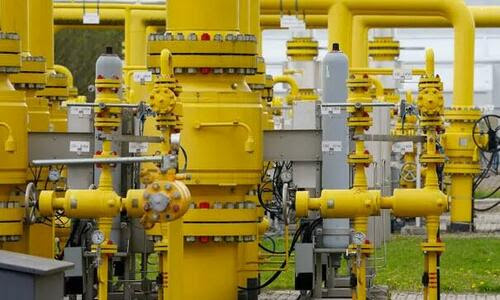
It is unclear which EU countries Guylas was referring to. Russian energy giant Gazprom has already shut off supplies to Poland and Bulgaria after both refused to pay in rubles, but a Bloomberg report last week stated, as Gulyas did, that 10 of the bloc’s member states have already set up accounts with Gazprombank, and four have actually paid for Russian gas using this mechanism.
On Thursday, EU officials confirmed that any company agreeing to open a rouble account in Russia and pay for gas that way would be in breach of sanctions, but as The Guardian detailed last week, there could be a loophole.
According to further guidance issued by the EU last week, the Kremlin’s decree does not stop gas importers asking Gazprom to agree the purchase is legally complete once the first payment, in euros or dollars, has been deposited at Gazprombank.
Any conversion into roubles would take place thereafter, meaning the buyer would not technically have breached sanctions. Another option, the guidance says, is for buyers to make a public declaration that they consider the purchase complete once their dollar or euro payment is made. The only obstacle to this, according to the guidance, is the need for “confirmation from the Russian side” that all of this complies with decree 172.
In other words, Gazprom – or effectively the Kremlin – has to be onboard. Gazprom and Gazprombank are not subject to EU sanctions, so buyers are permitted to negotiate such labyrinthine proposals without breaching sanctions.
Tactics like these appear to be what the likes of OMV and Uniper are examining. Uniper said it was looking into “concrete payment modalities” that would allow it to pay while complying with sanctions.
This apparent legal loophole significantly clouds the picture over the true nature of compliance with Putin’s demand. For instance, responding to reports that OMV was preparing to make rouble payments, the Austrian chancellor, Karl Nehammer, insisted this was not the case.
Gulyas said that Hungary has opened a euro account with Russia’s Gazprombank, which then converts payments into rubles before transferring them to suppliers in Russia. This system, as The Guardian explains, allows European buyers to comply with Putin’s demand, made in late March, that “unfriendly” countries switch to Russia’s national currency to buy its natural gas.
“There are nine other countries using the same payment scheme,” said Gulyas, adding that “there should be no doubt in anyone’s mind that countries importing raw materials from Russia use exactly the same method to pay for Russian gas.”
So, as Gulyas confirmed, while numerous nations are exploiting this loophole to go along with Putin’s demands, these countries’ leaders will never it, in order to ensure they are seen as “being a good European.”
“…because today the idea of being a good European also means that the leaders of those countries are not honest when speaking either in the international arena or to their own people, the other nine countries won’t say that they are doing the same thing.”
Let the denials begin…
end
ITALY
Italy Says It’s Open To Paying For Russian Gas In Rubles…Then Denies It
MONDAY, MAY 02, 2022 – 12:25 PM
While the Germans and Austrians throw their support behind a Russian oil embargo, the Italians are once again breaking with their EU peers and pushing for more flexibility to continue purchasing Russian energy, even if it requires converting their euros to rubles, as President Vladimir Putin has demanded.

Politico reports that European energy companies should – provisionally, at least – be allowed to comply with Russian demands to pay for gas in rubles, according to remarks from Roberto Cingolani, the Italian minister in charge of the country’s energy security.
“I think it would be good for a few months, at least, to allow companies to go ahead and pay in rubles, while we understand the legal framework and implications,” he told POLITICO, adding that he wants “a speedy and very clear pronouncement from the European Commission” confirming that oil and gas companies can pay in rubles for the time being.
But roughly an hour after the original headlines hit the tape, other Italian officials decided that they didn’t want to risk the wrath of their European peers (as talk of disunity proliferated), so they quickly got the word out and clarified that Italy has no concrete plans to pay for Russian energy in rubles.
- ITALY DENIES IT’S PLANNING TO PAY FOR GAS IN RUBLES: OFFICIAL
And as we noted earlier, Hungary has already exposed the hypocrisy of its European peers by exposing how they are already effectively bending to the demands of the Russian leader.
Meanwhile, Rome is bracing for a possible cutoff of Russian gas with measures to save energy, and even keep coal-fired plants operating longer.
During the original interview with Politico, Cingolani added that it could take months to understand legal implications of Russia’s request to receive rubles payments for gas. To be clear, the European Commission has warned companies not to open ruble-denominated accounts, warning that doing so could be considered a breach of sanctions levied against Russia for invading Ukraine. Its guidance says utilities can pay in euros (which would be considered final under existing contracts) and then Russia could convert the euros into rubles later.
This creates a serious Catch-22 for oil and gas companies, Cingolani explained:
“I believe oil and gas companies cannot risk paying and then being accused of having broken sanctions, but at the same time they cannot risk…not paying in rubles,” he said ahead of Monday’s crisis talks of EU energy ministers in Brussels. “These are long-term contracts, the costs would be extremely high.”
While Cingolani’s ministry is preparing contingency plans in the event that Italy is cut off from Russian energy supplies in a similar manner to Poland and Bulgaria, he has also proposed a workaround that might satisfy the Kremlin and the European Commission.
His proposed workaround is similar to the Commission’s. The EU energy company would regard the euro payment as the final transaction while Russia could instead consider the ruble payment after conversion. But he acknowledged such an approach might be “optimistic.”
“In this process there are gray areas, which could constitute a breach of sanctions. However you do it there is a problem.”
Italy is presently in a state of “pre-alert,” the lowest of three crisis levels envisaged in its national gas emergency plan, which he said meant “constant observation and monitoring.”
END
GERMANY
Germany threatens immediate embargo on Russian oil
(zerohedge)
Germany Threatens Immediate Embargo On Russian Oil
MONDAY, MAY 02, 2022 – 09:50 AM
With Emmanuel Macron back secure in his second term, and the latest conflict over gas supplies between Moscow, Poland and Bulgaria sending shudders through the European community, the Germans – newly emboldened by a deal to access LNG terminals belonging to its European neighbors as it scrambles to build more of its own – are once again threatening to cut off Russian oil and gas by the end of the summer.
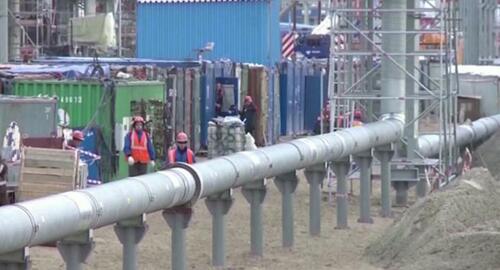
The latest comments come via German newspaper Welt and Finance Minister Christian Lindner, who said an immediate Russian oil embargo is a distinct possibility.
Not only is Berlin open to discussing the boycott of Russian energy, but he insisted that such an outcome would be viable.
German support for an oil embargo would mark a major turnaround from earlier this year, when Europe’s biggest economy (which remains heavily dependent on Russian energy, as we have repeatedly shown) had dragged its feet.
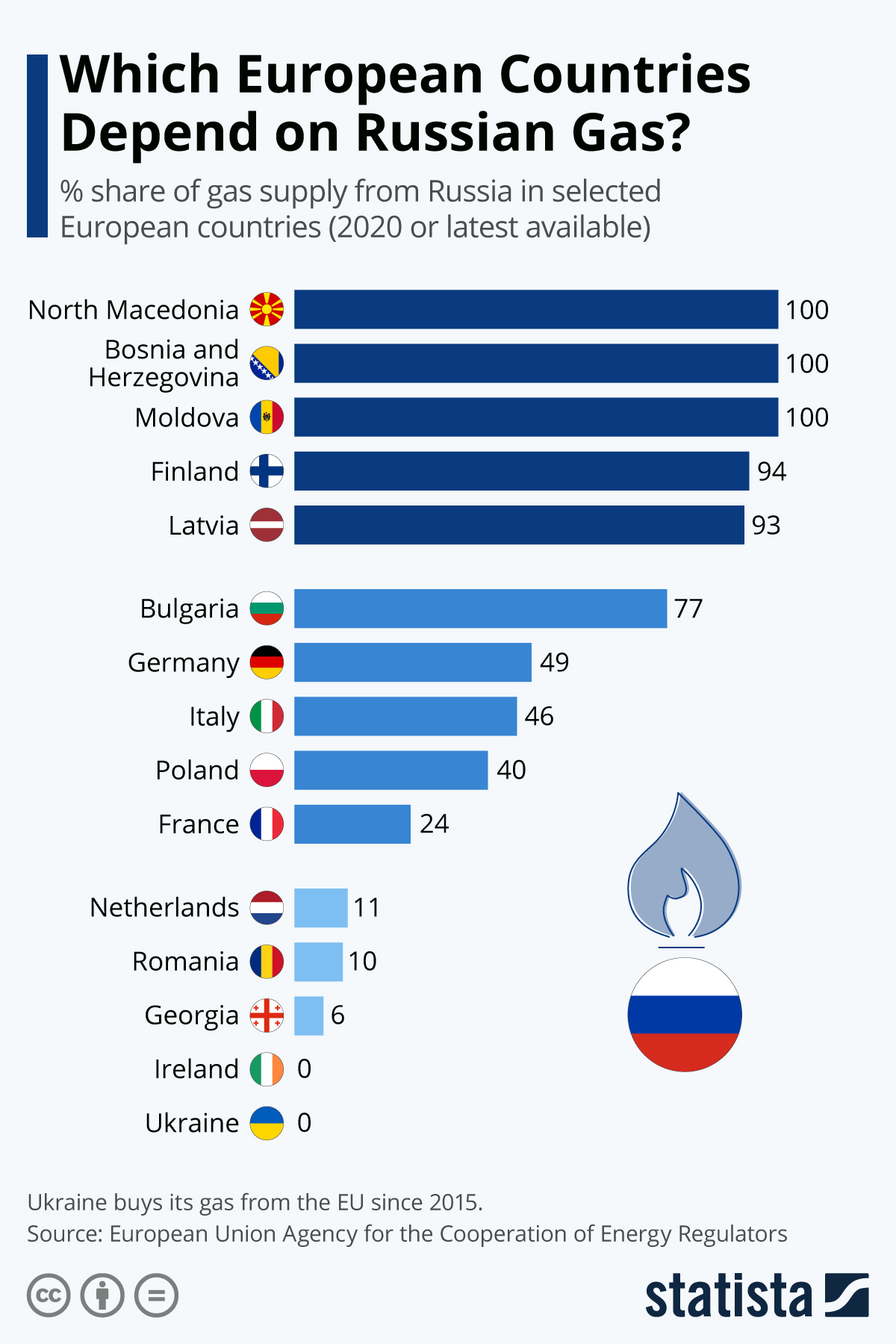
You will find more infographics at Statista
Lindner’s comments follow similar remarks from German Foreign Minister Annalena Baerbock, who said last night that Berlin was ready to support a gradual, EU-wide embargo on Russian oil imports. FT writes that Germany would still need at least a few months to prepare itself, assuming agreement to a “phased-in ban” akin to what was done with coal:
Germany has called for a phased-in ban on Russian oil imports into the EU, stepping up pressure on Brussels to find a deal between divided member states ahead of a crunch week for the bloc’s policy on Russian energy.
Jörg Kukies, one of chancellor Olaf Scholz’s closest advisers, said Berlin was in favor of an oil embargo, but needed a “few months” to prepare for an end to Russian crude shipments. Germany had previously said it would need until the end of the year.
While the EU has already agreed to stop importing Russian coal, countries that border Ukraine or Russia, including Poland and the Baltic States, have been calling for an oil ban as well. Economy and Climate Minister Robert Habeck said Sunday that he expects Germany could be fully independent of Russian crude oil imports by the end of summer.
But meanwhile, Newsquawk cautions in a note: “Newsflow has been heavily focused on a potential Russian oil/gas embargo, with Hungary remaining heavily opposed; however, Politico reports of a potential compromise for such member nations.”
Oil prices were tumbling Monday morning, although prices bounced on the headlines hinting at an embargo. The comments come as EU members are laying the groundwork for yet another package of economic sanctions targeting Russia. Ukraine’s foreign minister, Dmytro Kuleba, told the EU’s top diplomat over the weekend that the bloc’s next round of sanctions against Moscow must include an oil embargo.
end
GERMANY
Deutsche bank’s main offices raided by police two days after the younger Broksmit found dead
(zerohedge)
Deutsche Bank Offices Raided By Police On Money Laundering Concerns
SATURDAY, APR 30, 2022 – 08:45 AM
It looks as though Chief Executive Christian Sewing could actually be making an attempt to clean things up at Deutsche Bank, after years of regulatory issues at the bank. In fact, Deutsche Bank headquarters is reportedly being searched at this moment as part of an ongoing money laundering case that it appears the bank tipped off regulators to.
The bank’s offices in Frankfurt are being searched by law enforcement authorities “after the lender flagged potential money laundering,” Bloomberg wrote on Friday morning.
The raid includes officials from the Frankfurt prosecutors office and Germany’s BKA federal police, the report continues. The searches are taking place following the decision by a Frankfurt court, the report says.
Additionally, representatives of financial regulator BaFin were also involved in the search, Reuters reported.
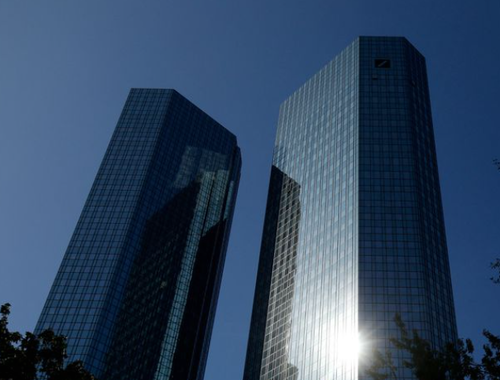
Deutsche Bank said in a statement that the search relates to “reports made by the bank of suspected money laundering” and the bank said it is “cooperation [sic] fully with authorities”. Reuters confirmed that the search was due to a tip from the bank, stating “the search involved suspicious transactions it had itself passed on to authorities”.
“Police officers are present in and around Deutsche Bank’s Frankfurt headquarters”, Bloomberg confirmed Friday morning. However, one witness told Reuters “there was no sign of authorities outside the bank’s headquarters on Friday”.
Deutsche Bank made the following statement:
“This is an investigative measure by the Frankfurt public prosecutor’s office in connection with suspicious activity reports filed by the bank. Deutsche Bank is fully cooperating with the authorities.”
Meanwhile, Deutsche has been under the microscope for potential money laundering for years, facing nearly $700 million in fines for trades that authorities said were used to illegally launder money.
end
FRANCE
did we expect anything less?
French Election FRAUD Puts 2020 To Shame — Millions Of Uncounted Le Pen Ballots Found [VIDEO] – enVolve
Inbox
| Robert Hryniak | Sat, Apr 30, 5:34 PM (15 hours ago) |   | |
to |
Seriously, you expected a honest vote ?
5. RUSSIAN AND MIDDLE EASTERN AFFAIRS
UKRAINE/USA
USA sending in 121 new Phoenix ghost tactical drones to the Ukraine.
(zerohedge)
DoD Sends “Phoenix Ghost” Kamikaze Drones To Ukraine
SUNDAY, MAY 01, 2022 – 10:45 PM
The Department of Defense announced it was sending “121 Phoenix Ghost Tactical Unmanned Aerial Systems” to Ukraine. The never-before-seen kamikaze drone is a brand-new weapon system designed for ambushing Russian tanks.
As reported by Breaking Defense, the Phoenix Ghost tactical drone is similar to the Switchblade drone already fielded in Ukraine.
Not much is known about the new drone. The DoD described it as a “one-way” drone that will “deliver a punch” and said it would operate similar to the Switchblade drone system.

The War Zone reported that Pentagon Press Secretary Jack Kirby said the Phoenix Ghost’s capabilities differ from Switchblades.
“I’m gonna be loath to get into much more detail about the system at this point for classification purposes, but you can safely assume that, in general, it works,” Kirby said. “It provides the same sort of tactical capability that a Switchblade does. Switchblade is a one-way drone if you will, and it clearly is designed to deliver a punch. It’s a tactical UAS, and Phoenix ghost is of that same category.”
California-based AEVEX Aerospace is the defense company that designed and manufactured Phoenix Ghost. The company markets itself as “a recognized leader in full-spectrum airborne intelligence solutions.”
The new drone is part of the latest U.S. arms package to Ukraine. Here’s what’s included:
- Over 1,400 Stinger anti-aircraft systems;
- Over 5,500 Javelin anti-armor systems;
- Over 14,000 other anti-armor systems;
- Over 700 Switchblade Tactical Unmanned Aerial Systems;
- 90 155mm Howitzers and 183,000 155mm artillery rounds;
- 72 Tactical Vehicles to tow 155mm Howitzers;
- 16 Mi-17 helicopters;
- Hundreds of Armored High Mobility Multipurpose Wheeled Vehicles;
- 200 M113 Armored Personnel Carriers;
- Over 7,000 small arms;
- Over 50,000,000 rounds of ammunition;
- 75,000 sets of body armor and helmets;
- 121 Phoenix Ghost Tactical Unmanned Aerial Systems;
- Laser-guided rocket systems;
- Puma Unmanned Aerial Systems;
- Unmanned Coastal Defense Vessels;
- 14 counter-artillery radars;
- Four counter-mortar radars;
- Two air surveillance radars;
- M18A1 Claymore anti-personnel munitions;
- C-4 explosives and demolition equipment for obstacle clearing;
- Tactical secure communications systems;
- Night vision devices, thermal imagery systems, optics, and laser rangefinders;
- Commercial satellite imagery services;
- Explosive ordnance disposal protective gear;
- Chemical, Biological, Radiological, Nuclear protective equipment;
- Medical supplies to include first aid kits.
Russia’s Ambassador to the U.S., Anatoly Antonov, accused Biden of pumping Ukraine with weapons:
“The U.S. authorities do not seem to be interested in a ceasefire. What matters for John Kirby and his colleagues is that the American military-industrial complex receives additional income by getting rid of obsolete weapons from their warehouses,” Antonov said.
So far, the Biden administration has committed more than $4 billion in security assistance to Ukraine and has just requested a whopping $33 billion more. The massive request includes billions of dollars for economic and humanitarian aid.
END
Besieged Azovstal Steel Plant “Worse Than Hell” As UN Brokers ‘Safe Passage Operation’ For 100 Civilians
MONDAY, MAY 02, 2022 – 08:30 AM
Now multiple weeks into a standoff where Azov fighters and Ukrainian civilians have been holed up in a large Mariupol steel plant while surrounded by Russian forces who have total control of the city, another round of successful civilian evacuations as been accomplished. The United Nations has dubbed it a ‘safe passage operation’.
“Evacuation of civilians from Azovstal began,” Zelensky said on Twitter over the weekend. The group of at least 46 civilians which initially exited the massive Azovstal Iron and Steel Works mill are expected to arrive in the Ukrainian controlled city of Zaporizhzhia on Monday. Follow-up reports put the total number of civilians leaving the plant at 100, after the latest pause in fighting was secured with the help of the United Nations and Red Cross.
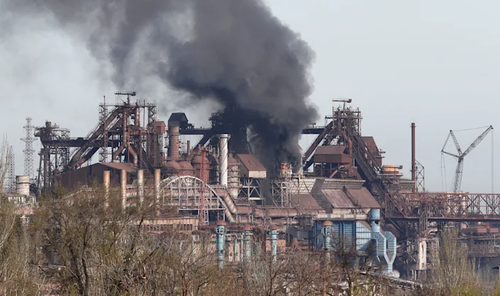
The past couple weeks have seen a series of short-lived ceasefires at the plant, mostly for the purpose of allowing the estimated trapped few hundred or up to 1,000 civilians to safely exit, facilitated on the outside by Russian forces who control the area above ground.
Last month Russia’s military said it was ordered not to go into the cavernous plant, which has several floors underground, and to instead wait it out. The estimated couple thousand mostly Azov fighters – and what’s also believed to possibly be foreign mercenaries as well – have for many days been perpetually low on supplies and it’s only a matter of time before they are forced to emerge.
The situation has been described as “hell” for those fighters and civilians still trapped:
Mariupol Mayor Vadym Boychenko said at a press conference Friday that supplies inside the plant are dwindling: “It is not a matter of days, it’s a matter of hours,” he said, adding: “If Mariupol is hell, Azovstal is worse.”
Some of those who upon the start of the invasion sought shelter at the Azovstal complex may have been there for two months at this point. Surrounding Russian forces have ordered Azov members – who are part of an acknowledged neo-Nazi regiment – to lay down their weapons and surrender.
The destroyed city’s mayor was further cited as saying that “women, children and the elderly – who have been stranded for nearly two months – will be evacuated to the city, where they will receive immediate humanitarian support, including psychological services.”
Meanwhile, over the weekend House Speaker Nancy Pelosi became the most senior US official to meet with President Volodymyr Zelensky on the ground in Kiev since the war’s beginning.
She said during the surprise visit, “We are visiting you to say thank you for your fight for freedom, that we’re on a frontier of freedom and that your fight is a fight for everyone. And so our commitment is to be there for you until the fight is done.”
They spent a little over three hours on the ground. The delegation included the following: “…Reps. Gregory Meeks of New York, who chairs the House Foreign Affairs Committee, Adam Schiff of California, the chairman of the House Intelligence panel, and Jim McGovern of Massachusetts, who leads the House Rules Committee. Democratic Reps. Bill Keating of Massachusetts, Barbara Lee of California and Jason Crow of Colorado were also part of the delegation, according to Pelosi’s office,” as listed by CNN.
end
SHEER INSANTIY
Russian TV Warns Britain Can Be ‘Drowned In Radioactive Tsunami’ By Single Nuclear Sub Strike
MONDAY, MAY 02, 2022 – 11:45 AM
A recent Russian state TV program has stirred outrage and made headlines across the United Kingdom after a television presenter featured a simulated demonstration of how the Russian navy’s nuclear submarines would take out the UK with ease.
The segment aired late last week on public broadcaster “Channel One” and featured the chairman of the nationalist Rodina political party, Aleksey Zhuravlyov, who declared that “one Sarmat missile and the British Isles will be no more.”
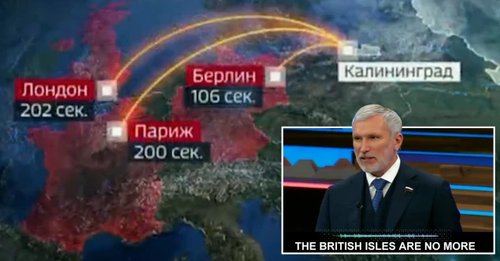
Specifically under discussion was the UK’s military support to Ukraine. London was earliest out of the gate to publicize it’s repeat planeloads of weapons, including anti-tank systems and munitions, flown into Ukraine.
That’s when the segment transitioned to news anchor Dmitry Kiselyov describing the following as a graphic of a submarine played behind him:
“It approaches its target at a depth of 1km at a speed of 200km/h. There’s no way of stopping this underwater drone. The warhead on it has a yield of up to 100 megatons.”
“The explosion of this thermonuclear torpedo by Britain’s coastline will cause a gigantic tsunami wave up to 500m high.”
The clip from the segment, which is now being widely shared in the West…
He then said the UK could be turned into “a radioactive desert” in the most provocative moment of the program:
“Such a barrage alone also carries extreme doses of radiation. Having passed over the British Isles, it will turn what might be left of them into a radioactive desert.”
The panel had started off by reacting to recent comments by UK’s Armed Forces Minister, who appeared to earlier give approval for Ukraine striking Russian soil utilizing UK-provided weapons if need be.
British Defence Secretary Ben Wallace issued the remarks last Thursday while describing Ukraine’s right to defend itself.
“Part of defending itself in this type of invasion is obviously where Ukraine will go after the supply lines of the Russian army because without fuel and food and ammunition, the Russian army grinds to a halt and can no longer continue its invasion,” he told BBC TV.
But he did note the caveat that it remains unlikely. “They currently don’t have British weapons that could do that, so it’s unlikely that it is our weapons,” he said, and added: “We’re very unlikely to supply that to anyone simply because of the technology and also the scarcity we have of those capabilities. So it is very unlikely.”
END
UKRAINE/USA/POLAND
Pelosi’s ‘Victory’ Rhetoric During Surprise Trip To Kiev Making Some Allies Nervous
MONDAY, MAY 02, 2022 – 01:45 PM
House Speaker Nancy Pelosi’s surprise Sunday trip to Ukraine’s capital made her the highest-ranking US official to meet in-person with President Volodymyr Zelensky since the war began. The delegation also included the following: “…Reps. Gregory Meeks of New York, who chairs the House Foreign Affairs Committee, Adam Schiff of California, the chairman of the House Intelligence panel, and Jim McGovern of Massachusetts, who leads the House Rules Committee. Democratic Reps. Bill Keating of Massachusetts, Barbara Lee of California and Jason Crow of Colorado were also part of the delegation, according to Pelosi’s office,” as listed by CNN.
But Pelosi’s rhetoric during the about 3-hours spent on the ground before heading back across the border to Poland has some allies very nervous, given it signals likely continued escalation. She stated in Sunday morning comments that Washington will support the Ukrainians “until victory is won” against Russia.

She described to reporters that the purpose of her trip was “to send an unmistakable and resounding message to the entire world: America stands firmly with Ukraine.” Significantly it comes a week following the ‘high risk’ trip of Secretary of State Antony Blinken and Defense Secretary Lloyd Austin to Kiev.
During Pelosi’s trip the Ukrainian side also thanked the US delegation for Biden’s recent mammoth $33 billion aid package for the Ukrainians, and yet the consistent message out of Kiev has still been give us more, more, more.
“I am thankful to you for this signal of strong support for Ukraine,” Zelensky later said after meeting with Pelosi. And the Democratic House speaker later stressed before reporters in Poland: “America stands with Ukraine. We stand with Ukraine until victory is won. And we stand with Nato.”
On Monday she met President Andrzej Duda in Warsaw. She called him “a valued partner in supporting the people of Ukraine in the face of [Russian President Vladimir] Putin’s brutal and unprovoked war.”
However, The New York Times has emphasized in a fresh report that some US allies are alarmed by America’s ratcheting rhetoric yet without agreed upon definable goals. “But if there is a new allied consensus about supplying Ukraine with heavier and more sophisticated weapons for the latest stage of the war in eastern Ukraine, there is no allied consensus about switching the war aim from Ukraine to Russia,” the report lays out.
Europe, which has with the exception of the UK remained consistently more reluctant in what it’s willing to do – fearing actions like sending tanks will be seen by Moscow as hugely escalatory – is described by commentary featured in the Times as being dragged into a broader conflict:
There is a sense in Europe that “the US is dragging everyone into a different war”, said Professor François Heisbourg, a French defense analyst, citing similar comments by Mr Biden about “the butcher of Moscow” and how “Putin must go”. Some wonder what Washington is trying to say – or do.
“To help Ukraine prevail is not about waging war against Russia for reasons related to its governance,” Prof Heisbourg said. “Regime change may be a vision but not a war aim.”
He and others said that such talk from Washington plays perfectly into Mr Putin’s narrative that Nato is waging war against Russia, and that Russia is fighting a defensive war for its survival in Ukraine.
Indeed this has been the fear of many American pundits from the beginning – however which rarely get a platform in mainstream media. Instead, the major networks have tended to feature only the most hawkish voices, even as likely the majority of Americans remain fearful of any potential WW3 scenario.
RUSSIA/POLAND
Regarding Russia, Poland Needs to Grow Up – The American Conservative
Inbox
| Robert Hryniak | 8:55 AM (28 minutes ago) |   | |
to |
I really hope Poland wakes up to reality and gets past being a eager American proxy for conflict with Russia. Ideas of past historical lands of the Ukraine in Galicia will not come without much blood. And in the end, historically that is the birthplace of the Bandora crowd who committed terrible shocking atrocities against the Polish people during WWII. To think such emitting ideology has died is quite naive. Look at the Azov crowd and the ever growing surfacing reports of atrocities committed against Ukrainians by this crowd.
Otherwise, Poland will find itself as a lone combatant which NATO will not save but use on the altar of sacrifice to further box in Russia. Yes, Poland will be sacrificed just like the Ukrainians are being sacrificed. And Polish attempts at seizing Russian gas state assets in Poland will not be without a bitter price. Nor will German chatter of seizing a Russian refinery be, without a cost. It is child like thinking, as does no one understand such a refinery of gas assets rely on the flow of piped energy from Russia?
So as this coming week week progresses and a new one comes forth we will watch more sheer foolishness and more conflict and more death. All of which may well punish Russia and its’ citizens to restrict their placeholder hegemony. Lloyd Austin gave away the plot when this week he stated the plan is to deny Russia the ability to threaten anyone and why the conflict must continue. Does he understand this is a NUCLEAR power and not a 3rd world country? Apart from a cheerleader for the military complex, he is a dangerous delusional fool. There is a point to which Russia will tolerate this conflict and then a line will be crossed and all bets are off to what the response will be. Sadly, the deliberate care not to destroy Ukrainian infrastructure to save Ukrainian lives will soon be forgotten in what will be a broader conflict. This is tragedy not needed.
None of us will remain unaffected whether by direct involvement or by economic fallout. And the world remains very much divided over what it sees happening, in what really is a proxy war whereby America is using NATO as “lead from behind” effort to confront Russia. And while public silence remains about the thousands of NATO troops in the Ukraine; whether expansion of this conflict will remain silent is not likely. The reality is that we are footsteps away from a actual confrontation, one that may become a nuclear one localized or global.
The reality is that today, the West has lost sight of the very thing that created and gave the West the standing it has. And that is simply TRADE and the financial standing that it brought. London became the powerhouse clearing center followed by New York and the USD became the standard of Settlement for TRADE. Sadly, seizure of National STATE assets in other countries whether financial or fixed is a assault on national independence and international trade. Why does any thinking person believe that the vast world outside of the NATO and the UK and America is not horrified by the western actions? Seizure or can we say outright theft of assets brings NO creditability to actions albeit shallowly covered by vilification of Russia over the conflict in the Ukraine. And while one might overlook American bio labs and the like as justification. This will not be the case with a broader expanded conflict in days ahead. As foolish naive leadership tempts fate.
America badly needs to restore creditability in its’ actions and its’ moral leadership as do others because if this does not happen soon; the avalanche of departure from the USD in global trade will upset not just trade but actual settlements to the point where being a Reserve currency will be a passing fancy, becoming a memory. And this has ramifications for everyone, no matter which nation one is in or what one does. And given the current upheavals of trade and broken supply chains everything will become much worse, leading to a much greater and broader level of chaos. Chaos breeds conflict and a lack of order. The question is who will step up to keep a mantle of order to prevent the chaos that will otherwise occur????
>
> https://www.theamericanconservative.com/articles/regarding-russia-poland-needs-to-grow-up/
6// GLOBAL COVID ISSUES/VACCINE MANDATE/
Dr Paul Alexander and Peter McCullough
McCullough and Rose paper showing myocarditis in young males pulled by journal, pulled, we are at a new level now, the journal ‘after’ publishing and then gets leaned on by pharma, pulls your paper…
As I said, medical journal publishing is dead, evidence-based medicine is dead (EBM), journal editors are corrupted malfeasants now, and COVID did this, they all succumbed to grant money, doing tricks
| Dr. Paul AlexanderMay 2 |
This was the punishing graph, share it, for you do not even need see/read the pulled paper, this picture tells the story they did not want to be told…so share it please…
in short, if you allow your teen son or daughter to get these vaccines, any boosters, you risk serious harm or even death…myocarditis is not mild and never goes away, the heart muscle is dead, scarred for good, it will come knocking in 20 or so years when they are 35 or so…be warned.
Anyone who tells you that your child should take the vaccine and that myocarditis is mild, you spit on them, tell I said to spit on them…and walk away. no vaccine for the youngster. chance the virus once healthy…we have put out enough for you to know how to manage this COVID now…trust you, trust yourself as parents and take control.
https://www.sciencedirect.com/science/article/pii/S0146280621002267?via%3Dihub

GLOBAL ISSUES//
Brought this to your attention on Friday: farmers are reducing fertilizer use and it may wreck crop yields
(zerohedge)
Alarming Signs Farmers Reduce Fertilizer May Wreck Crop Yields
SUNDAY, MAY 01, 2022 – 06:05 PM
There is growing concern farmers worldwide are reducing chemical fertilizer, which may threaten yields come harvest time, according to Bloomberg. The repercussions could be huge: Lower yields may exacerbate the food crisis.
There are alarming signs commercial farmers in top growing areas in the world are decreasing the use of essential nutrients — nitrogen, phosphorus, and potassium.
Revealed last week, SLC Agricola SA, one of Brazil’s largest farming operations, managing fields of soybeans, corn, and cotton fields in an area larger than the state of Delaware, will reduce the use of fertilizer by 20% and 25%.
Coffee farmers in Brazil, Nicaragua, Guatemala, and Costa Rica, some of the largest coffee-producing countries, are expected to spread less fertilizer because of high costs and shortages. A coffee cooperative representing 1,200 farmers in Costa Rica predicts coffee output could slip 15% next year because of soaring fertilizer costs.
The International Fertilizer Development Center (IFDC) warned a reduction in fertilizer use would shrink yields of rice and corn come harvest time. Farmers in China, India, Bangladesh, Indonesia, and Vietnam — the largest rice-producing countries — are spreading less fertilizer, and may result in a 10% reduction in output, equating to about 36 million tons of rice, or enough food to feed a half billion people.

More fertilizer equals more food production; Less fertilizer equals lower food production. It’s a simple concept to understand and may suggest an even larger food crisis is on the horizon.
The US won’t be spared. Chairman of the Kansas Wheat Commission Gary Millershaski said his “biggest fear” this spring is that farmers in North America skip out on applying nitrogen to wheat plantings. He said, if farmers did, this might suggest harvests would be a “lower class of wheat.”
In March, Tony Will, the chief executive of the world’s largest nitrogen fertilizer company CF Industries Holdings Inc., warned: “My biggest concern is that we end up with a very severe shortage of food in certain areas of the world.”
Rockefeller Foundation President Rajiv Shah provided Bloomberg Television’s David Westin with a timeline of when the “massive, immediate food crisis” begins. He said, “in the next six months.”
end
A must read
Brandon Smith..
Food Shortages In Six Months – The Globalists Are Telling Us What Happens Next
SUNDAY, MAY 01, 2022 – 10:10 PM
Authored by Brandon Smith via Alt-Market.us,
In mid 2007 the Bank for International Settlements (The central bank of central banks) released a statement predicting an impending “Great Depression” caused by a credit market implosion. That same year the International Monetary Fund also published warnings of “subprime woes” leading to wider economic strife. I started writing alternative economic analysis only a year earlier in 2006 and I immediately thought it was strange that these massive globalist institutions with far reaching influence on the financial world were suddenly starting to sound a lot like those of us in the liberty movement.
This was 16 years ago, so many people reading this might not even remember, but in 2007 the alternative media had already been warning about an impending deflationary crash in US markets and housing for some time. And, not surprisingly, the mainstream media was always there to deny all of our concerns as “doom mongering” and “conspiracy theory.” Less than a year later the first companies awash in derivatives began to announce they were on the verge of bankruptcy and everything tanked.
The media response? They made two very bizarre claims simultaneously: “No one could have seen it coming” and “We saw this coming a mile away.” Mainstream journalists scrambled to position themselves as the soothsayers of the day as if they said all along that the crash was imminent, yet, there were only a handful of people who actually did call it and none of them were in the MSM. Also ignored was the fact that the BIS and IMF had published their own “predictions” well before the crash; the media pretended as if they did not exist.
In the alternative media we watch the statements and open admissions of the globalists VERY carefully because they are not in the business of threat analysis; rather, they are in the business of threat synthesis. That is to say, if something goes very wrong in the world economically, central bankers and money elites with aspirations of a single centralized economic authority for the world are ALWAYS found to have a hand in that disaster.
For some reason, they like to tell us what they are about to do before they do it.
The idea that globalists artificially create economic collapse events will of course be criticized as “conspiracy theory,” but it is a FACT. For more information on the reality of deliberate financial sabotage and the “order out of chaos” ideology of globalists please read my articles ‘Fed One Meeting Away From Creating A Doomsday Sinkhole’ and ‘What Is The Great Reset And What Do The Globalists Actually Want?’
The Great Reset agenda proposed by WEF head Klaus Schwab is just one example of the many discussions hidden in plain sight by globalists concerning their plans to use economic and social decline as an “opportunity” to quickly establish a new one world system based on socialism and technocracy.
The primary problem with discerning what the globalists are planning is not in uncovering secret agendas – They tend to openly discuss their agendas if you know where to look. No, the problem is in separating the admissions from the disinformation, the lies from the truth. This requires matching up globalist white papers and statements to the facts and evidence at hand in the real world.

Let’s look specifically at the food shortage problem in detail…
Food Shortages In Six Months
A week ago there was a torrent of press releases from global institutions all mentioning the same exact same concern: Food shortages within the next 3 to 6 months. These statements line up very closely with my own estimates, as I have been warning regularly about impending dangers of inflation leading to food rationing and supply chain disruptions.
The IMF, the BIS, World Bank, The UN, the Rockefeller Foundation, the World Economic Forum, Bank of America and even Biden himself are all predicting a major food crisis in the near term, and it is not a coincidence that the policies of these very institutions and the actions of puppet politicians that work with them are causing the crisis they are now predicting. That is to say, it’s easy to predict a disaster when you created the disaster.
The claim is that Russia’s invasion of Ukraine is the primary cause, but this is a distraction from the real issue. Yes, sanctions against Russia will eventually lead to less food supply, but the globalists and the media are purposely ignoring the bigger threat, which is currency devaluation and price inflation created by central banks pumping out tens of trillions of dollars in stimulus packages to prop up “too big to fail” corporate partners.
In 2020 alone, the Fed created over $6 trillion from nothing and air dropped it into the economy through covid welfare programs. Add that to the many trillions of dollars that the Fed has printed since the credit crash in 2008 – It has been a nonstop dollar destruction party and now the public is starting to feel the consequences. Lucky for the central bankers that covid struck and Russia invaded Ukraine, because now they can deflect all the blame for the inflationary calamity they have engineered onto the pandemic and onto Putin.
Inflation hit 40 year highs in the US well before Russia invaded Ukraine, but let’s consider the ramifications of that war and how it affects the food supply.
The Russian invasion certainly disrupts Ukrainian grain production, which makes up around 11% of the total world wheat market. Russia also maintains a 17% share and together these two nations feed a large swath of third world nations and parts of Europe with 30% of wheat and barley exports, 19% of corn exports, 23% of canola exports, and 78% of sunflower exports.
It is the sanctions on Russia that are a problem well beyond Ukraine, however, as Russia also produces around 20% of global ammonia and 20% of global potash supplies. These are key ingredients to fertilizers used in large scale industrial farming. Farmers are estimating an overall price spike of around 10% in food markets, but I believe this is very conservative. I am already seeing overall price increases of at least 20% from six months ago, and I expect there to be another 30% in price hikes before this year is over. In other words, we are looking at 50% in average increases in 2022.
Official government inflation data and CPI cannot be trusted. Double whatever numbers they give and you will be much closer to the truth. The inflation rate used by Shadowstats.com, calculated using methods once applied by the US government in the 1980s before they “adjusted” their models to hide the data, supports my position so far.
The expectation among US agricultural experts is that China will fill the void where Russian supplies disappear, but it’s a mistake to make this assumption.
Something Weird Is Going On In China
China’s crackdown on covid infections has reached levels so bizarre I have to ask the question: Are their lockdowns really about covid, or are they hiding something else?
The death rate of covid in China is impossible to calculate accurately because they have never released proper data that can be confirmed. However, almost everywhere else in the world we see a median infection fatality rate of 0.27% for covid; meaning, over 99.7% of people in the world on average have nothing to fear in terms of dying from the virus. But in China, the CCP is acting as if they are dealing with the Black Plague. Why?
Lockdowns have resulted in food shortages across the country as supply chains become strained and manufacturing remains shut in many cases. The story many westerners are not hearing much about, though, is the fact that Chinese exports have essentially been frozen. This is very important so I think it needs emphasis – Over 1 IN 5 container ships IN THE WORLD are now backed up in Chinese ports due to their covid lockdowns. This is incredible.
Why would China do this over a virus we all know is not dangerous to the vast majority of people? Why institute the worst lockdown in the country so far and starve their own people when the majority of Western governments have now given up on their pandemic fear mongering and the forced vaccination agenda?
I would suggest the possibility that China might already be engaging in an economic war that many Americans and Europeans don’t even realize is going on. This may be a beta test for a shut down of exports to the US and Europe, or it is an incremental shutdown that is meant to become permanent. The bottleneck on trade may also be a precursor to a Chinese invasion of Taiwan.
Taiwan is actually more dependent and intertwined with China’s economy than many people know. China is the biggest buyer of Taiwan’s exports and those exports account for 10% of Taiwan’s GDP. Taiwan has hundreds of thousands of workers and businessmen that travel regularly to China to work, another economic factor that is now strained by lockdowns. Furthermore, Taiwan has multiple corporations that operate their factories on mainland China, all of which could be closed due to covid lockdowns.
All I’m saying is, if I was China planning on invading Taiwan in the near future, I might consider using covid as a cover for damaging their economy first and disrupting their export model. Communists see the population as a utility that can be sacrificed if necessary, and China is perfectly willing to cause short term suffering to their people if it means long term gains for the party. Beyond that, if I was going to engage in economic warfare with the west covertly, what better way than to tie up 20% of the world’s cargo ships and disrupt supply chains in the name of protecting the country form a “pandemic?”
The bottom line? Don’t rely on China to fill export needs for fertilizer ingredients or anything else as sanctions on Russia continue.
Inflation vs. Supply vs. Control
It’s not just globalist organizations talking about incoming food shortages; the CEO of international food corporation Goya has also recently warned we are on the precipice of a food crisis. As I have noted in the past, inflation leads to government price controls, price controls lead to lack of production incentives (profits), lack of profits leads to loss of production, loss of production leads to shortages, and shortages lead to government rationing (control over all large food sources).
As we have seen with almost every authoritarian regime in modern history, control over the food supply is key to controlling the population. It is only surpassed as a strategic concern by control over energy (which we will also see shortages of soon as Europe sanctions Russian oil and gas and starts eating up supplies from other exporters). The food issue hits closest to home because we can see the effects immediately on our wallets and on our families. There is nothing worse for many parents than the prospect of their children going hungry.
The mainstream media is once again ignoring any potential economic threat, specifically they are denying the notion of food shortages as something to be worried about. I say, why listen to a group of people that are always wrong on these types of events? If anything, I would at least take the words of the globalists seriously when it comes to economic collapse; they benefit the most from such disasters after all, and they also have the most influence when it comes to triggering crisis.
Preparedness today costs nothing tomorrow. Lack of preparedness today costs EVERYTHING tomorrow. The choice for anyone with a brain is simple – Get prepared for the end of affordable and easily available food before this year is out.
VACCINE INJURIES
COVID Vaccine Side Effects on Pregnant Women
Date: April 29, 2022Author: user0 Comments
https://www.theepochtimes.com/mkt_app/what-ive-seen-in-the-last-two-years-is-unprecedented-physician-on-covid-vaccine-side-effects-on-pregnant-women_4428291.html
‘What I’ve Seen in the Last 2 Years Is Unprecedented’: Physician on COVID Vaccine Side Effects on Pregnant Women
Former Pfizer VP: ‘Adverse impacts on conception and ability to sustain a pregnancy were foreseeable’
By Enrico Trigoso
April 27, 2022 Updated: April 29, 2022
Dr. James Thorp is an extensively published 68-year-old physician MD board-certified in obstetrics and gynecology, as well as maternal-fetal medicine, who has practiced obstetrics for over 42 years.
Thorp told The Epoch Times that he sees 6,000–7,000 high-risk pregnant patients a year and has seen many complications among them due to the COVID vaccines.
“I’ve seen many, many, many complications in pregnant women, in moms and in fetuses, in children, offspring,” Thorp said, “fetal death, miscarriage, death of the fetus inside the mom.
“What I’ve seen in the last two years is unprecedented,” Thorp asserted.
Thorp explained that although he has seen an increase in fetal death and adverse pregnancy outcomes associated with the COVID-19 vaccination, attempts to quantify this effect are hampered by the imposition of gag orders on physicians and nurses that were imposed in September 2021, as reviewed in the publication “Patient Betrayal: The Corruption of Healthcare, Informed Consent and the Physician-Patient Relationship” (pdf).
At the beginning of January, the FDA was ordered to release its first large batch of documents related to Pfizer’s COVID jab trials, of which over 10,000 of about 450,000 pages have been made public so far.
From the first day of the Pfizer-BioNTech vaccine rollout on Dec. 1 2020 through Feb. 28, 2021, 1,223 deaths and 42,086 adverse events were reported to Pfizer.
Among the adverse events, particularly alarming are the ones that affected pregnant women. The documents say that there were 274 pregnancy adverse events, of which 75, or 27 percent were “serious.”
“49 non-serious and 75 serious, reported clinical events, which occurred in the vaccinated mothers. Pregnancy related events reported in these cases coded to the [patients] Abortion spontaneous (25), Uterine contraction during pregnancy, Premature rupture of membranes, Abortion, Abortion missed, and Foetal death (1 each). Other clinical events which occurred in more than 5 cases coded to the [patients] Headache (33), Vaccination site pain (24), Pain in extremity and Fatigue (22 each), Myalgia and Pyrexia (16 each), Chills (13) Nausea (12), Pain (11), Arthralgia (9), Lymphadenopathy and Drug ineffective (7 each), Chest pain, Dizziness and Asthenia (6 each), Malaise and COVID-19 (5 each),” reads the previously confidential Pfizer documents (pdf).
The CDC website recommends the COVID vaccines during pregnancy in order to “prevent severe illness and death in pregnant women.”
The American College of Obstetricians and Gynecologists (ACOG) also “strongly recommends that pregnant individuals be vaccinated against COVID-19,” adding that pregnant women’s complete vaccination should be a “priority.”
Thorp repeatedly emphasized that it’s not that everybody got their shots when the vaccine was first distributed.
“They were not all administered [on Dec 1, 2020,]” Thorp said. “All the lots that were sent out were deep-frozen on-site and then they were administered slowly over that eight weeks.”
The amount of BioNTech vaccines shipped worldwide at the time has been redacted in the aforementioned document.
“Why did they redact that? That would have been unbelievable information that would give you the exact numerator and denominator,” Thorp said.
The “general overview” table says that there were 29,914 “cases” related to females, 9,182 in males, and 2,990 people with “no data,” of which 19,582 are “recovered/recovering,” 11,361 “not recovered at the time of the report” and 1,223 “fatal.”
Former Pfizer VP Had Given Warnings
Michael Yeadon is a big pharma veteran with 32 years in the industry. He retired from Pfizer whilst occupying the most senior research position in that field.
“On December 1, 2020, We detailed a series of mechanistic toxicology concerns which we believed were reasonable to hold, unless & until proven not to occur,” Yeadon said in a statement to The Epoch Times.
“Among those was that adverse impacts on conception and ability to sustain a pregnancy were foreseeable.”
“It’s important to note that none of these gene-based agents had completed what’s called ‘reproductive toxicology.’ Over a year later, this battery of tests in animals still has not been done. So there was and still is no data package supporting safety in pregnancy or prior to conception.”
Dr. Wolfgang Wodarg and Yeadon detailed the concerns on the issue: the spike protein from the virus encoded in the vaccines was related to a minor extent to syncytin that plays a crucial part in the carrying of a baby to term.
Yeadon had hoped, back then, that their concerns were paid attention to, since they had already seen the tragedy of thalidomide, a sedative drug that caused congenital malformation, over 60 years ago.
“During 2021, I came across two further pieces of evidence which made it much more likely that there’d be adverse effects on pregnancy from COVID-19 ‘vaccines.’”
“It looked like someone had tried to dismiss our concerns by testing for evidence of the particular problem we’d warned about in Dec. 2020. Unfortunately, all they did is to reinforce our concerns. We’d envisioned the risk that, in responding to the synthetic piece of virus spike protein, women’s immune systems would also make an immune response to their own placental protein,” Yeadon said. “That’s exactly what was reported in the pre-print paper.”
“Based on this concern alone, all of these experimental products as a class should have been completely contraindicated in women younger than menopause.”
mRNA Products Accumulate in Ovaries
Another concern that they had not initially noticed was that “the mRNA products (Pfizer & Moderna) would accumulate in ovaries,” Yeadon stated.
“An FOI request to the Japanese Medicines Agency revealed that product accumulation in ovaries occurred in experiments in rodents. I searched the literature based on these specific concerns and found a 2012 review, explicitly drawing attention to the evidence that the lipid nanoparticle formulations as a class do, in fact, accumulate in ovaries and may represent an unappreciated reproductive risk to humans. This was ‘a well known problem’ to experts in that field.”
A 2012 study says that after testing with different mouse species and Wistar rats, “a high local accumulation of nanoparticles, nanocapsules and nanoemulsions in specific locations of the ovaries was found in all animals.”
Referring to the study, Yeadon told The Epoch Times that “The authors tell untruths. They say something like ‘there was no increase in anti-syncytin-1 antibodies.’”
“No, that’s wrong. Their data is clearly 2.5X increased after vaccination and obviously statistically significant (functional significance is looking confirmed by the miscarriage rate),” Yeadon noted.
“What they’ve done is cute. They’ve chosen a completely arbitrary level they scribed on the figure below which they claim nothing matters. No evidence whatsoever for that claim. In fact, in the discussion, they confess we don’t know the relationship between antibodies and the impact on function.”
The former Pfizer VP believes that the pharmaceutical industry “definitely knew,” since 2012, that the lipid nanoparticles would accumulate in the ovaries of women that took the vaccines.
“No one in the industry or in leading media could claim ‘they didn’t know about these risks to successful pregnancy.’”
A lipid nanoparticle is an extremely small particle, it’s a fat-soluble membrane that is the cargo of the messenger RNA, Thorp said.
Dr. James Thorp (Courtesy of James Thorp)
She told The Epoch Times last October about how were women being affected by the vaccines.
Pfizer and Moderna did not respond to requests for comment.
end
/VACCINE IMPACT
Food Shortages In Six Months – The Globalists Are Telling Us What Happens Next
April 29, 2022 12:42 pm

In the alternative media we watch the statements and open admissions of the globalists VERY carefully because they are not in the business of threat analysis; rather, they are in the business of threat synthesis. That is to say, if something goes very wrong in the world economically, central bankers and money elites with aspirations of a single centralized economic authority for the world are ALWAYS found to have a hand in that disaster. For some reason, they like to tell us what they are about to do before they do it. The idea that globalists artificially create economic collapse events will of course be criticized as “conspiracy theory,” but it is a FACT. As we have seen with almost every authoritarian regime in modern history, control over the food supply is key to controlling the population. It is only surpassed as a strategic concern by control over energy (which we will also see shortages of soon as Europe sanctions Russian oil and gas and starts eating up supplies from other exporters). The food issue hits closest to home because we can see the effects immediately on our wallets and on our families. There is nothing worse for many parents than the prospect of their children going hungry. The mainstream media is once again ignoring any potential economic threat, specifically they are denying the notion of food shortages as something to be worried about. I say, why listen to a group of people that are always wrong on these types of events? If anything, I would at least take the words of the globalists seriously when it comes to economic collapse; they benefit the most from such disasters after all, and they also have the most influence when it comes to triggering crisis. Preparedness today costs nothing tomorrow. Lack of preparedness today costs EVERYTHING tomorrow. The choice for anyone with a brain is simple – Get prepared for the end of affordable and easily available food before this year is out.
Governments Worldwide are Working in Lockstep to bring in Digital I.D. & Social Credit System as EU agrees to Expand Online Censorship with ‘Digital Services Act’
April 30, 2022 1:11 pm
Under pressure applied by both Hillary Clinton and Barack Obama, the European Union is working to expand online censorship to an extreme Orwellian level, as well as strictly regulate speech during what authorities deem to be times of crisis (we always seem to be in the middle of a “crisis”), and remove online anonymity by forcing the public to have a digital identity. But these plans aren’t unique to the EU. They are also currently being rolled out in the UK and Africa, proving Governments worldwide are working in lockstep to bring in a digital identity and social credit system right under your nose. Hillary Clinton and Barack Obama both lobbied for the EU to back the censorship bill known as the ‘Digital Services Act‘ on Thursday, April 21st, 2022. There is a coordinated effort worldwide to bring in a digital identity and social credit system right under your nose.
Michael Every
Michael Every on the day’s most important topics
Rabo: There Is War; No Trust; Deranged Speech; And Lack Of Endgame Vision From Both Sides
MONDAY, MAY 02, 2022 – 10:46 AM
By Michael Every of Rabobank
Is ‘Mayday’ One Word or Two?
There is not a lot to laugh about anywhere at the moment. However, a recent very black humor meme that did make me do so was the one I saw a few days ago where:
Putin looks at Defence Minister Shoigu and says, “Tell me how the war is going in one word.”
Shoigu replies, “Good.”
Putin follows up, “Tell me in two words.”
Shoigu says, “Not good.”
It’s ‘funny’ because it’s true. Russia is creating an economic basket-case in a breadbasket and calling it ‘peace’, with global repercussions, yet it is doing the same to itself. A Russian friend tells me he went to his Moscow department store Saturday and took the escalator to the underground level to find the retailer he wanted. The retailer was gone, and the entire level replaced with a vegetable market. I told him to worry when there aren’t any vegetables either.
RUB is trading well vs. EUR due to high energy prices, capital controls, and a collapse in imports – but nobody is trading it or wants to hold it. Russian officials talk about a new financial and currency system and RUB pegged to gold or commodities, as if it isn’t already a commodity currency – but isn’t gold priced in US dollars? Weren’t South African Krugerrands literally gold money the West banned anyway? Moreover, Russian central bank governor Nabiullina says pegging RUB to gold is “not being discussed at all.”
Longer term, consider this point from not-at-all a US flag-waver Milanovic:
“In the next decade or so, the history of economic policy will be enriched by a new, never imagined, experiment: how to accomplish technologically regressive import substitution? This is the problem that Russia will have to face and that is entirely new….
The industrial areas that are normally the backbone of traditional (predigital) development were well developed in the Soviet Union, but have been abandoned, left to deteriorate and, even if existing, are today technologically obsolete. Almost all of what is technologically advanced was produced, or was dependent in part, on Western-made technologies…
Even if Russian regressive import substitution is successful in terms of output, which is very doubtful,…once the Russian market gets reopened and sanctions lifted, all that effort will be shown to have been in vain because the new and created-from-scratch Russian models would be less efficient than Western.”
In other words, the ‘we can do it alone’ policy either fails now, or Russia has to permanently decouple via a step down the industrial technology ladder, which its labor force is not set for. Even worse, the US is allegedly planning to offer Russia’s hi-tech work force special visas to deliberately try to brain-drain it.
Or China fills the technology gap, and the West does to them what it is doing to Russia. For those who say that can’t happen, the Financial Times reports China is worried enough that it can that they just called in all large local and foreign banks to discuss how it might be able to circumvent a SWIFT ban and the seizure of its FX assets, as happened to Russia. The conclusion was that there is no way to avoid it, even if the pain would be enormous for both sides – but arguably far worse for net food and energy importer China.
Frankly, this is hardly what China needs when its manufacturing PMI was 47.4 vs. 47.3 consensus, non-manufacturing 41.9 vs. 46, and the Caixin manufacturing PMI 46 vs. 47.
True, Chinese markets had a stand-out frenetic rally on Friday, in contrast to the gloom in the rest of the world, due to a Politburo promise to roll back regulatory crackdowns. They said the same a few weeks ago: then cracked down. And a few months ago: then cracked down. Indeed, there is a sting in the tail again, as the Wall Street Journal notes: “Regulators are planning to hold off on new rules that limit the time young people spend on mobile apps, according to one of the people, while another person said that Beijing is considering pushing some of its biggest tech companies to offer 1% equity stakes to the state and give the government a direct role in corporate decisions.”(!) That sounds like de facto nationalization on the cheap. If so, expect more ‘CCP apps’ and a lot more time spent on them? After all, what else is one to do when one is in a hard lock-down for the next eight months?
Xi Jinping also gave a speech later on Friday which reiterated the Marxist-Leninist Common Prosperity orthodoxy yet again that, “By its nature, capital purses profits, and if it is not regulated and restrained, it will bring immeasurable harm to economic and social development.” The SCMP covered it thus: ‘Chinese president outlines big role for private capital – as long as it’s on a regulatory leash’. Some say, “OK, invest where the government says and watch the profits roll in.” Except the sectors one backed on that basis have underperformed; and, as I suggested last year, the best return you will get is akin to a government bond yield – low, and in China’s case, falling.
And so to geopolitics.
The Ukraine war is a bloody stalemate with tens of thousands of dead on both sides. Russia, already accused of war crimes, is talking about “filtration camps” in areas it controls that ‘weed out’ people seen as too Ukrainian, while sending mainly women and children off to Russia to be ‘Russified’. State TV is pushing a nuclear attack on the UK, or setting off an underwater nuke to wipe out the British Isles with a tsunami. We usually get this kind of talk from Iran and North Korea. Russia’s Foreign Minister Lavrov just claimed Ukraine’s President Zelenskiy can be a Nazi despite being Jewish because “some of the worst anti-Semites are Jews,” and “Hitler had Jewish blood”. We usually get that kind of talk from ISIS.
Today is the May Day holiday in Europe, but next Monday is Russia’s Victory Day. Military analysts had expected Putin to grind out a Tacitus-style win by then. However, with more Western weaponry pouring into Ukraine, along with Nancy Pelosi, that seems unlikely. There are suggestions Putin may now use the military parade to officially declare war and mobilize. (Which does not sit with the tight fiscal policy of a gold standard by the way.)
As the risks of escalation increase, Noam Chomsky just gave an interview in which he declared the only possible exit is a pan-European security structure for all to join, or Helsinki 2.0 – and the one statesman who he says could make that deal happen is “Donald J. Trump”. Cue paroxysms from those who prevented that path from being taken –if it ever really could have– from 2017-2020 because of the need to paint Trump’s 2016 win as due to Putin via Russiagate rather than being the legacy of awful neoliberal policies, only some of which he changed, i.e., trade politics.
(Russiagate, being disassembled by Special Counsel Durham, was something the head of the new Disinformation Governance Board under the Department of Homeland Security said was ‘true’, while Hunter Biden’s laptop was ‘false’. Here, she channels Mary Poppins to explain why her role is important for a crowd who thinks ‘Hamilton’ is anti-Trump rather than a Trumpian economic policy. In 2020, she sung a different tune to Congress when saying, “I totally understand your aversion to the idea that government would fight back against disinformation. In fact, you know, the use of that term has been basically the foundation to some very draconian fake news laws in places like Russia… I do not believe that government should be in that business either.”)
However, Chomsky is likely wrong in that this particular Helsinki 2.0 ship looks to have sailed, as Finland moves to join NATO, for example – one of the few ships that actually can sail, as global supply logjams build up again.
There is war; no trust; increasingly deranged speech; and lack of end-game vision from both sides. Even if Russia did sign up to a new Helsinki, somehow, it would just alienate China,… unless the new Helsinki is a global free-for-all. In which case, why bother?
Relatedly, as the US and UK are reported to have met to discuss future tactics over Taiwan, as of today lower-ranked Chinese PLA officers will have more scope to supervise senior ranks: experts say this is aimed at better securing the PLA’s loyalty to Xi Jinping. And why should this be needed, one wonders? To add to tensions, this week may see the public launch of the latest US Indo-Pacific strategy, aimed squarely at China.
Against that backdrop, this week will show that major central banks think the economy can be summed up in one word – “Inflation”.
After all, Europe is limping towards cutting off Russian oil by end-2022, perhaps. Moreover, Bloomberg notes that food prices are going to soar as fertilizer use plummets:
“For the first time ever, farmers the world over –all at the same time– are testing the limits of how little chemical fertilizer they can apply without devastating their yields come harvest time. Early predictions are bleak.
In Brazil, the world’s biggest soybean producer, a 20% cut in potash use could bring a 14% drop in yields, according to industry consultancy MB Agro. In Costa Rica, a coffee cooperative representing 1,200 small producers sees output falling as much as 15% next year if the farmers miss even one- third of normal application. In West Africa, falling fertilizer use will shrink this year’s rice and corn harvest by a third, according to the International Fertilizer Development Centre, a food security non-profit group…
For the billions of people around the world who don’t work in agriculture, the global shortage of affordable fertilizer likely reads like a distant problem. In truth, it will leave no household unscathed. In even the least-disruptive scenario, soaring prices for synthetic nutrients will result in lower crop yields and higher grocery-store prices for everything from milk to beef to packaged foods for months or even years to come across the developed world. And in developing economies already facing high levels of food insecurity? Lower fertilizer use risks engendering malnutrition, political unrest and, ultimately, the otherwise avoidable loss of human life.”
So, perhaps central banks need two words, not one – but they are going to be “rate hikes”.
First up tomorrow will be the RBA, with a looming election and a teetering housing market. The market thinks 15bp to take rates to 0.25% is most likely; even that is seeing ‘For Sale’ signs hit lawns. Of course, both big parties in the election favor of pushing up house prices even further – or at least that’s what the impact of their related policies would be. This is Oz after all.
Then we get the Fed, where 50bp is a done deal. The issue will be over how hawkish or dovish the wording and Q&A from Powell is. Then we get the BOE and another 25bp hike to 1%.
Tell me in one word how markets are going to react. Then tell me in two words.
END
7. OIL ISSUES
8 EMERGING MARKET& AUSTRALIA ISSUES
Australia//// NEW ZEALAND/ SOUTH AFRICA/BRAZIL/ARGENTINA/INDIA
BRAZIL
END
Your early currency/gold and silver pricing/Asian and European bourse movements/ and interest rate settings MONDAY morning 7:30 AM
Euro/USA 1.0523 DOWN .0006 /EUROPE BOURSES //MOSTLY OFF/MAY DAY HOLIDAY
USA/ YEN 129.96 UP 0.428 /NOW TARGETS INTEREST RATE AT .11% AS IT WILL BUY UNLIMITED BONDS TO GETS TO THAT LEVEL…
GBP/USA 1.2561 UP 0.0008
Last night Shanghai COMPOSITE CLOSED UP 71.58 PTS OR 2.41%
Hang Sang CLOSED HOLIDAY
AUSTRALIA CLOSED DOWN 1.03% // EUROPEAN BOURSES CLOSED HOLIAY
Trading from Europe and ASIA
I) EUROPEAN BOURSES CLOSED HOLIDAY
2/ CHINESE BOURSES / :Hang SANG CLOSED
/SHANGHAI CLOSED
Australia BOURSE CLOSED DOWN 1.03
(Nikkei (Japan) CLOSED DOWN 29.37 PTS OR 0.31%
INDIA’S SENSEX IN THE RED
Gold very early morning trading: 1977.20
silver:$22.65
USA dollar index early MONDAY morning: 103.43 UP 46 CENT(S) from FRIDAY’s close.
THIS ENDS MONDAY MORNING NUMBERS
xxxxxxxxxxxxxxxxxxxxxxxxxxxxxxxxxxxxxxxxxxxxxxxxxxxxxxxxxxxxxxxxxxxxxxxxxxxxxxxxxxxxxxxxxxxxxxxxxxxxxxxxxxxxxx
And now your closing MONDAY NUMBERS 1: 00 PM
Portuguese 10 year bond yield: 2.05% UP 4 in basis point(s) yield
JAPANESE BOND YIELD: +0.224% up 0 AND 8/10 BASIS POINTS /JAPAN losing control of its yield curve/
SPANISH 10 YR BOND YIELD: 2.01%// up 4 in basis points yield
ITALIAN 10 YR BOND YIELD 2.85 UP 15 points in basis points yield ./
GERMAN 10 YR BOND YIELD: RISES TO +0.950% IN BASIS POINTS ON THE DAY//
THE IMPORTANT SPREAD BETWEEN ITALIAN 10 YR BOND AND GERMAN 10 YEAR BOND IS 1.75% AND NOW ABOVE THE 3.00% LEVEL WHICH WILL IMPLODE THE ENTIRE ITALIAN BANKING SYSTEM. AT 4% SPREAD THERE WILL BE A HUGE BANK RUN…
END
IMPORTANT CURRENCY CLOSES FOR MONDAY
Closing currency crosses for FRIDAY /USA DOLLAR INDEX/USA 10 YR BOND YIELD/1:00 PM
Euro/USA 1.0507 DOWN 0020 or 20 basis points
USA/Japan: 130.27 UP .742 OR YEN DOWN 74 basis points/
Great Britain/USA 1.2505 DOWN 47 BASIS POINTS
Canadian dollar DOWN 0.0091 OR 01 BASIS pts DOWN to 1.2896
xxxxxxxxxxxxxxxxxxxxxxxxxxxxxxxxxxxxxxxxxxxxxxxxxxxxxxxxxxxxxxxxxxxxxxxxxxxxxxxx
The USA/Yuan, CNY: closed ON SHORE (CLOSED ..DOWN 6.6062
THE USA/YUAN OFFSHORE: (YUAN CLOSED (DOWN)..6.6826
TURKISH LIRA: 14.88 EXTREMELY DANGEROUS LEVEL/DEATH WISH/HYPERINFLATION TO BEGIN.
the 10 yr Japanese bond yield at +0.224
Your closing 10 yr US bond yield UP 10 IN basis points from FRIDAY at 2.985% //trading well ABOVE the resistance level of 2.27-2.32%) very problematic
USA 30 yr bond yield: 3.051 UP 10 in basis points
Your closing USA dollar index, 103.60 UP 64 CENT(S) ON THE DAY/1.00 PM/
Your closing bourses for Europe and the Dow along with the USA dollar index closing and interest rates MONDAY: 12:00 PM
London: CLOSED
German Dax : CLOSED DOWN 201.59 POINTS OR 1.43%
Paris CAC CLOSED DOWN 95.41 PTS OR 1.92%
Spain IBEX CLOSED DOWN 162.80 PTS OR 1.92%
Italian MIB: CLOSED DOWN 433.35 PTS OR 1.39%
WTI Oil price 102.25 12: EST
Brent Oil: 105.29 12:00 EST
USA /RUSSIAN /// RUBLE RISES TO: 70.96 UP 0 RUBLES/DOLLAR
GERMAN 10 YR BOND YIELD; +.950
CLOSING NUMBERS: 4 PM
Euro vs USA: 1.0506 DOWN .0626 OR DOWN 62 BASIS POINTS
British Pound: 1.2492 DOWN .0062or 62 basis pts
USA dollar vs Japanese Yen: 130.15UP 0.611//YEN DOWN 611 BASIS PTS
USA dollar vs Canadian dollar: 1.2877 UP .0074 (CDN dollar DOWN 74 basis pts)
West Texas intermediate oil: 105.19
Brent OIL: 107,84
USA 10 yr bond yield: 2.989 UP11 points
USA 30 yr bond yield: 3.053 UP 11 pts
USA DOLLAR VS TURKISH LIRA: 14.89
USA DOLLAR VS RUSSIA///USA/ ROUBLE: 70.96 DOWN 0 ROUBLES (ROUBLE UP 0 ROUBLES/USA
DOW JONES INDUSTRIAL AVERAGE: DOWN 939.18 PTS OR 2.77%
NASDAQ 100 DOWN 601.25 PTS OR 4.47%
VOLATILITY INDEX: 34.34 UP 4.35 PTS (14.50%)
GLD: 176.91 DOWN 0.02 PTS OR 0.00%
SLV/ 21.04 DOWN .38 PTS OR 1.77%
end)
USA trading day in Graph Form
May-Day Mayhem: Stocks Dump’n’Pump, Bonds Blowout, & Commodities Chaotic
MONDAY, MAY 02, 2022 – 04:01 PM
While the Brits danced around their May-Poles (Google it), removing more of what little liquidity there was in global markets, Europe’s stock market suddenly puked overnight following a flash-crash in Stockholm (which was reportedly sparked by some shitty math by a Citi index trader)…
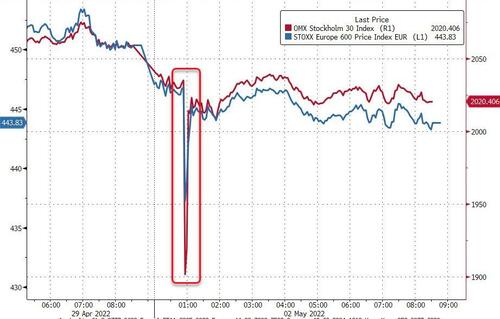
Source: Bloomberg
US Futures also puked very briefly at that time but it wasn’t until the European close that the real carnage started to hit in US equities. But after the chaos calmed down ray of hope appeared (not in any headlines of course) which seemed to spark a buying panic in the last hour of the day…
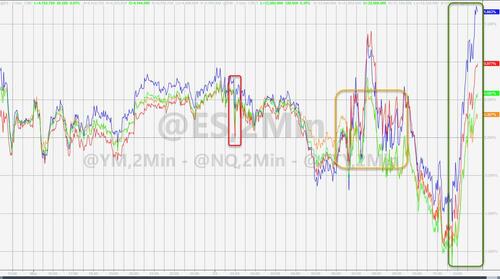
The explosion higher was sponsored by a VIX crushing move…
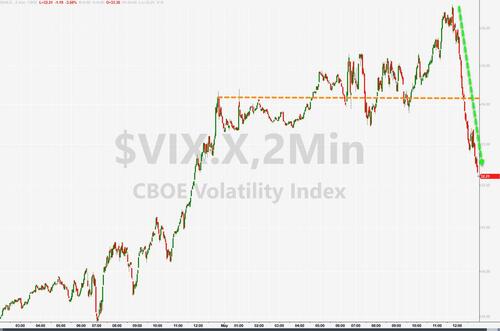
The S&P found support around 4050…

Which for those who follow SpotGamma, should have been a great opportunity…
Our models show a distinct kink in the gamma curves near 4050, which implies support in that area.
If we were to test 4050 pre-FOMC, we’d anticipate a bounce purely due to “options positioning”. This comes not only from large put positions, but there is a material amount of call positioning, too. Further a visit to this area would likely correspond with another surge in IV, and we believe dealers are long tail risk. This means that they are getting a vega payout, alleviating them of some short delta obligations. In turn, they can offer more liquidity which supports markets (we’ll aim to post this concept today).
The big miss in ISM Manufacturing, on top of last week’s surprise negative GDP print has sent the US Macro Surprise Index plunging…
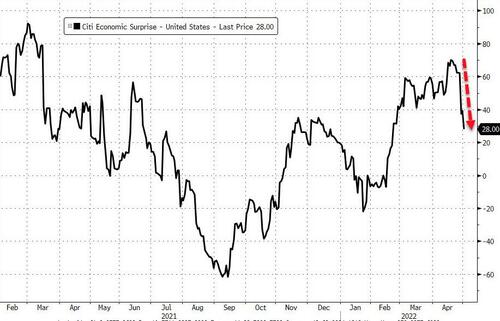
Source: Bloomberg
But bonds – for now – ain’t pricing for the imminent recession. TSY yields surged higher across the board today with the short-end outperforming. This will be the 6th straight week of Treasury losses if it holds through the chaos of The Fed.

Source: Bloomberg
10Y Yield tops 3.00% (3.0003% to be exact) for the first time since Dec 2018…

Source: Bloomberg
10Y Real yield goes positive for the first time since Mar 2020, spiking up to 0.16% intraday…
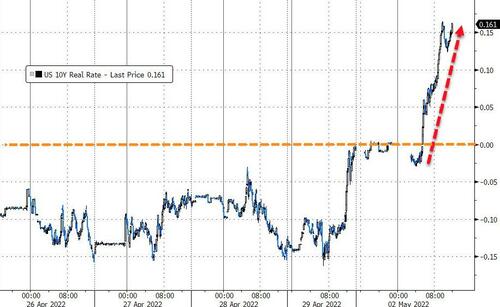
Source: Bloomberg
Bear in mind that the last time 10Y was here, Powell folded like a cheap suit and reversed his hawkish policy stance…
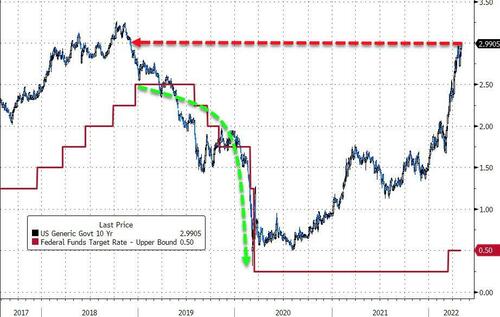
Source: Bloomberg
Earlier we noted that Japan has been dumping bonds with both hands and feet. We also note that the incentive for Japanese investors to pile-in at these levels is gone now, due to the surging cost of hedging the JPY…

Source: Bloomberg
Citadel’s Ken Griffin warned “we are in perhaps the highest uncertainty since the Great Financial Crisis,” adding that “we don’t know if inflation expectations have become unanchored.” He wasn’t finished as he warned the west is “facing existential problems” adding that the Biden administration is “deluging corporate American with regulation.”
STIRs are fully-priced for a 50bps this week by The Fed and are pricing-in 25% odds of a 75bps hike in June (with July and Sept both priced for 50bps hikes each)… and 10 more (25bp) hikes overall by year-end

Source: Bloomberg
The market remains notably more hawkish than The Fed’s Median Dot Plot… for now…
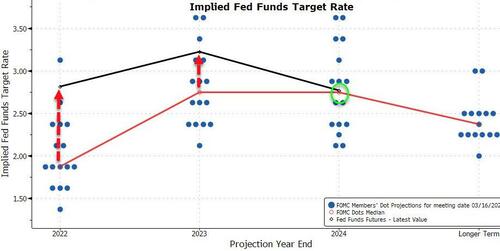
Source: Bloomberg
Credit markets continued to crack with HY Spreads at their widest since the COVID crisis…
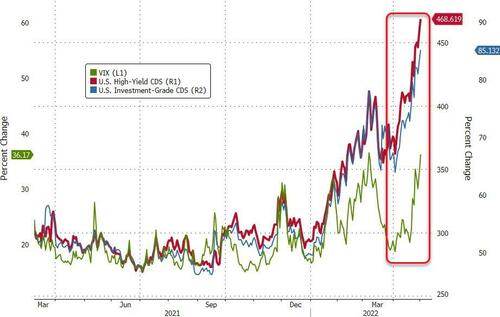
Source: Bloomberg
The dollar rebounded from Friday’s brief respite in its seemingly inexorable rise…

Source: Bloomberg
Bitcoin chopped around today, trading between $38k and $39k…
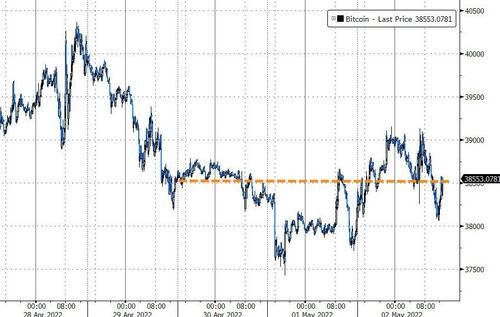
Source: Bloomberg
Gold was clubbed like a baby seal back below $1900 (now well below pre-Putin-invasion lows)…

US NatGas rallied 5% on the day…

Oil prices shot higher… after crashing overnight… to end unch…

Source: Bloomberg
Finally, if the STIRs market is indeed leading The Fed down this tightening path, then stonks have more pain ahead before reality sets in…
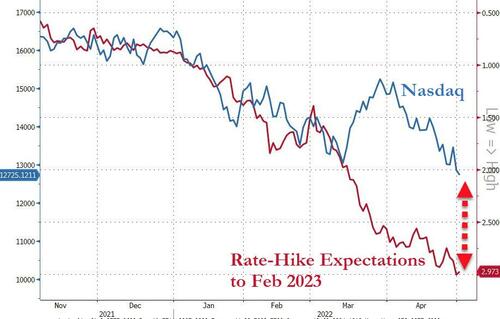
Source: Bloomberg
The question is – are stocks front-running Powell’s flip-flop back to QE as the pain becomes intolerable and political pressure unshakable.
END
I) /MORNING TRADING/GOLD TRADING
10Y Tops 3.00% For First Time Since 2018, Gold Dumps As Real Yields Turn Positive
BY TYLER DURDEN
MONDAY, MAY 02, 2022 – 12:55 PM
US 10Y Treasury yields just topped 3.00% this afternoon…
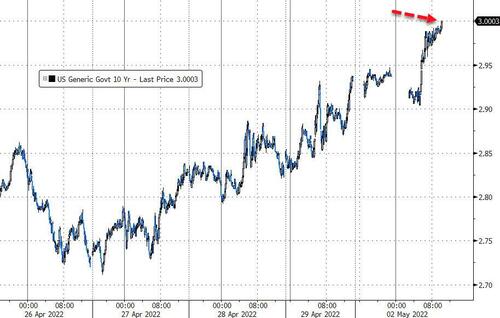
That is the highest yield since Dec 2018, right before Powell flip-flopped away from his hawkish stance…
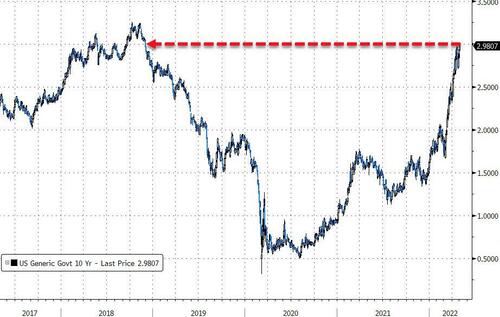
Source: Bloomberg
At the same time, 10Y real yields have surged back into positive territory…

…for the first time since March 2020…

Source: Bloomberg
Meanwhile, gold is under pressure once again, tumbling below $1900, and below pre-Putin-invasion lows…
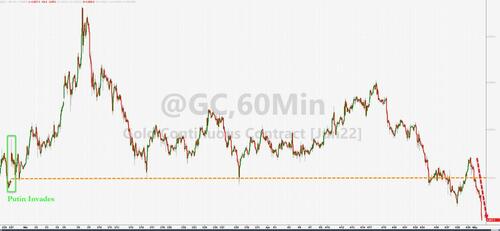
Back into the middle of its two-year range…
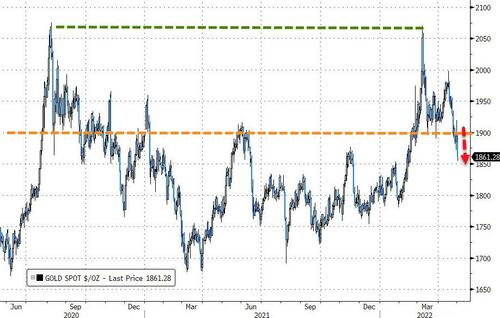
The equity markets are a shitshow of penny-stock-swings this morning with UK markets closed…

And liquidity near recent record lows…

The question is – when does the bond market start pricing in the imminent recession… and the subsequent flip-flop back to QE?
AFTERNOON
“That Escalated Quickly”: Mike Wilson Takes Victory Lap As Markets Crash, Sees S&P Tumbling To 3,400
MONDAY, MAY 02, 2022 – 01:10 PM
One week ago, Wall Street’s second biggest bear (after BofA’s Michael Hartnett who turned rather apocalyptic last Friday, and of course excluding SocGen’s Albert Edwards who is in a category of his own), said that “there is no place left to hide” in stocks as the rolling bear markets finally hit the broader index, and warned that the bear market rally (which he was correct about unlike all of his JPMorgan peers) was about to turn “grisly” (or is that grizzly).
Fast forward to his latest Weekly Warm-up note (available to professional subscribers in the usual place), where he takes a prompt, well-deserved (again) victory lap on his latest dismal forecast, and writes that after suggesting last week that the bear market was entering the phase when virtually nothing would work, even defensives, “based on the price action, that seems to be exactly what’s happening” with price action turning “especially vicious” last week as we enter the next phase of the bear market. Indeed, while the S&P 500 dropped “only” 3.4%, the breadth suggested the move was even worse with the cumulative advance / decline line making new lows for this bear market. Defensives were a very modest underperformer for the week (-0.5% relative) even though they remain the unequivocal leader year to date (+15% relative).
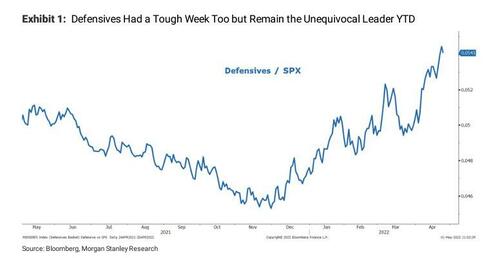
Meanwhile, the negative fundamental news and data points are piling up fast as – according to Wilson – they “tend to follow stocks that have been signaling bad news was coming” and as such, last week’s shockingly bad, pre-recessionary Q1 GDP at -1.4% fits the bill and “suggests Ice has arrived.“
What was behind last week’s sharp market repricing and earnings reassessment?
Recall one week ago – well before the dismal earnings from AMZN and the mediocre reports from the other gigacap GAMMA stocks – we said that “Q1 Earnings From Bad To Dismal: Tech Earnings Sliding, Guidance Collapsing.” Looking back, Wilson agrees that the catalyst for the sharp and broad move lower last week “was the growing evidence that growth is slowing faster than most investors believe. In short, we believe earnings estimates remain too high over the next 12 months even though 1Q results have been better than expected, once again.”
At the same time, another issue is that the quality of earning is deteriorating, and the commentary from management teams is getting incrementally cautious about the future path of growth. This, Wilson says, “is very much in-line with our view for earnings revisions breadth to continue falling as operating leverage turns negative. We think Amazon’s earnings and commentary from CEO Andy Jassy may encapsulate this view better than anything else:
“Today, as we’re no longer chasing physical or staffing capacity, our teams are squarely focused on improving productivity and cost efficiencies throughout our fulfillment network. We know how to do this and have done it before. This may take some time, particularly as we work through ongoing inflationary and supply chain pressures, but we see encouraging progress on a number of customer experience dimensions, including delivery speed performance as we’re now approaching levels not seen since the months immediately preceding the pandemic in early 2020.”
Meanwhile, Wilson also points to the S&P 500 real earnings yield which he observes is the most negative since the 1950s. As the MS strategist reminds us, the textbook view of valuation says that higher rates should lead to lower valuations, and sure enough today this story is painfully unfolding with “the highest inflation in 40 years and rates nearly doubling over the past two months, yet index valuations remain stuck at historically high levels.” Add 8%+ YoY inflation into the mix and we are left with the most negative real earnings yield back to the 1950s!
This has translated into real S&P 500 returns at -7% YoY, and means that “the S&P 500 has come full circle on the year, starting in May 2021 at 4200 and now nearly a year later, we’re at 4135.” Worse, if one factors in the latest March CPI at 8.5%, trailing 12 month real returns were -10%, -8% including dividends. The real return is even worse for the Nasdaq 100 (-15%), and the Russell 2000 (-25%), or as Wilson puts it, “Anyone who tells you we are in a bull market has got a lot of explaining to do.” We are confident Marko Kolanovic will get right on that…
Sarcasm aside, Wilson next makes a critical observation, noting that “perhaps stocks are no longer the inflation hedge investors expect” a point he made first several weeks ago in “Inflation Is No Longer A Positive For Earnings Growth… Or Stocks“. As he adds, “rising inflation should theoretically pass through to top-line growth, making stocks a historically safe bet against inflation. Why is this time different” he asks rhetorically and answers that “valuations are still near their highest levels ever as shown by the earnings yield and subtracting inflation gives you a real negative earnings yield. This theoretically means you’re buying -4% earnings contraction at today’s levels.“
Unfortunately, the plunging real earnings yield suggests even more downside from here according to Wall Street’s second most bearish analyst. Looking back at history, Wilson notes that the real earnings yield leads the real returns by ~6 months. While the relationship is not perfect, it has held true during the 2001 and 2008 cycle with the real earnings yield leading real returns lower. And while Morgan Stanley thinks real earnings yields will likely bottom soon as inflation peaks, the market will continue to move lower from here. In short, the “ice” phase that Wilson has been predicting for a year, is now front and center and hard to deny. Stocks have been warning of this for months and now the evidence is becoming more obvious to all.
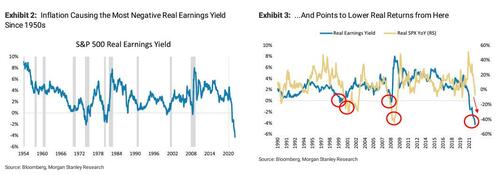
Meanwhile, even retail is realizing that pain is coming and margin accounts finally turned negative in April. Curiously, April is historically a strong seasonal month and 1Q22 earnings have been strong, yet the S&P 500 is down 8% and the NDX is down 12% in April. One possible factor in this according to Wilson, has been the first deleveraging in investor accounts since June 2020, as retail begins to sell (to hedge funds).
Why? Because rising rates are increasing the cost of margin while markets are 15-20% lower from 2021 highs, hurting the ‘buy the dip’ mentality. Here Wilson thinks that lower liquidity will continue to point to a broad de-rating and lower prices at the index level.
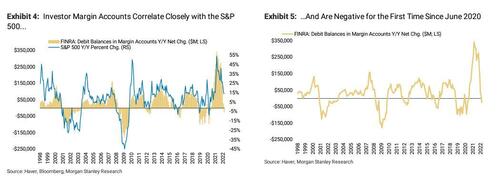
What does all this mean for stocks in the coming months? Nothing good: as Wilson concludes, from a technical standpoint “the S&P 500 has minimum downside to 3800 (-8%) in the near term. This represents 16x forward 12 month bottoms up consensus EPS which is looking more at risk now.” In other words, 16x is fair value… but if forward EPS starts to fall, there could be “much” more downside.
Which means that as Wilson highlighted back in January, the true technical support lies at the 200 week moving average if there is going to be a true growth scare with recession probabilities rising materially. Unfortunately for bulls, that currently comes in at 3460, or 16% lower. It also lines up with the pre pandemic highs of 3400 which seems to be where a lot of stocks have already ventured.
In many ways, Wilson concludes, “this makes perfect sense from the point of view that the pandemic did not create real value for the economy or most companies, but rather destroyed it.” On the positive side, even Wall Street’s 2nd biggest bear concedes that the market is currently so oversold, any good news could lead to a vicious bear market rally, something which Goldman discussed in its bullish note. Which is why Wilson writes that while he can’t rule anything out in the short term he wants to make it clear “this bear market is far from completed, in our view.”
There is more in the full Wilson note available to professional subscribers in the usual place.
END
II)USA data
ISM Manufacturing Disappoints, Employment Tumbles, Inflation Shows “No Signs Of Relenting”
MONDAY, MAY 02, 2022 – 10:07 AM
Analysts expected both ISM and PMI Manufacturing surveys to show improvement in April… and they did. However, S&P Global (Markit)’s Final print was notably below the preliminary print (59.2 vs 59.7 flash) but still above March’s print to its highest since Sept 2021 and ISM’s Manufacturing grossly disappointed, tumbling to its lowest since Sept 2020.
So take your pick – is US manufacturing the weakest since Sept 2020 or strongest since Sept 2021 just as Q1 GDP prints shockingly negative?

Source: Bloomberg
S&P Global reports that firms continued to pass higher material and staff costs on to clients in April, as the rate of charge inflation accelerated. The increase in selling prices was the fastest since last October
Contributing to the stronger upturn in the health of the manufacturing sector was a faster rise in output during April.
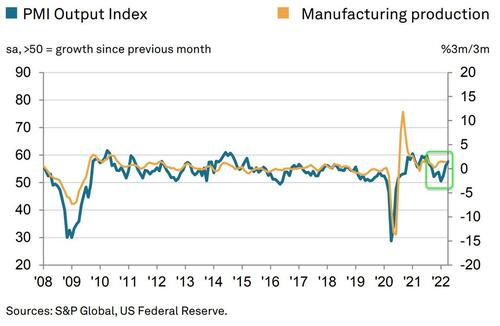
Meanwhile, new export orders grew at the fastest rate for almost a year.
Chris Williamson, Chief Business Economist at S&P Global, said:
“After a slow start to the year, which saw production growth almost stall, the manufacturing sector is starting the second quarter on a much stronger footing. Demand from consumers and businesses is proving encouragingly robust despite severe inflationary pressures, which intensified further during April.
“Both input cost and selling price inflation surged higher, the latter accelerating to a near-record rate, as firms faced rising energy prices, ongoing supplier-driven price hikes amid strained supply chains, and rising wage costs.
“In short, while the survey data add to indications that the pace of economic growth will improve in the second quarter after a lacklustre first quarter, the less welcome news is that elevated inflationary pressures show no signs of relenting.”
On the ISM side, it was considerably uglier (we assume they must just ask different questions in their survey?)

With employment tumbling to its weakest since Aug 2021…

As one respondent noted “At some point, the economy must give way; it will be tough to have real growth with such pressure on costs.”
There is certainly nothing in this report that would slow The Fed’s plan to unleash hawkish hell on markets.
-END-
end.
IIB) USA COVID/VACCINE MANDATES
end
iiia) USA inflation//SHIPPING commentaries//LOG JAMS//
end
IIIB) USA ECONOMIC STORIES
end
iv)swamp stories
The King Report (including swamp stories)
Let us close today with this offering courtesy of Greg Hunter and another interview James Rickards
More War, More Inflation and More Chaos
By Greg Hunter On April 29, 2022 In Weekly News Wrap-Ups121 Comments
By Greg Hunter’s USAWatchdog.com (WNW 527 4.29.22)
Don’t expect the war between Russia and Ukraine to be over anytime soon. VP Biden is asking for another $33 billion in military aid for Ukraine. The plan is to drag out the war and turn it into a quagmire to weaken Russia. This goofy and reckless path was recently admitted to by Secretary of Defense Lloyd Austin. What on earth could go wrong, especially with the southern border of the U.S. wide open for any enemy to cross over?
Inflation is here to stay, and it is getting worse. In the first leg up, energy led the charge for higher prices at the pump. Now, food inflation is growing with shortages on the horizon, according to Bob Unanue, CEO of Goya foods. He said on FOX Business “the world has weaponized food.”
Surprise! The first quarter was a negative 1.4%, and the Biden Administration policies are to blame. Now, the Fed is so worried about inflation it has said it is going to raise interest rates, but instead of fighting inflation, it looks like it will kill the economy altogether. Inflation, shortages and coming unemployment for a skidding economy will add more pain that is already baked into the financial cake. Look for a big revaluing of the U.S. dollar sooner than later, and expect more chaos and not less.
Join Greg Hunter of USAWatchdog.com as he talks about these stories and more in the Weekly News Wrap-Up for 4.29.22.
(end)
World Moving to Gold – James G. Rickards
By Greg Hunter On April 30, 2022 In Market Analysis37 Comments
By Greg Hunter’s USAWatchdog.com (Saturday Night Post)
Five-time, best-selling financial author James G. Rickards says, “We could be in a recession right now,” but the title of his most recent book “The New Great Depression” says where we are definitely going soon. Rickards says, “The current crisis is not like 2008 or even 1929. The New Depression that has emerged from the COVID pandemic is the worst economic crisis in U.S. history. Most fired employees will remain redundant. Bankruptcies will be common, and banks will buckle under the weight of bad debts. Deflation, debt and demography will wreck any chance of recovery, and social disorder will follow closely on the heels of market chaos.”
Rickards says there are many negatives to the current economy, Covid, inflation, war, sanctions, supply destruction, and on top of all that, Rickards says the Fed will ultimately kill the economy with a policy mistake. Rickards explains, “Probably in May they are going to have quantitative tightening, which means you actually reduce the money supply. So, this is triple tightening: Three interest rate hikes, no more taper . . . and doing quantitative tightening at a very rapid rate. What just happened? We had a down quarter. The economy was at recession levels in the first quarter, and the stock market is on the way down. So, here we go again. The Fed is tightening into weakness. It’s tightening into certainly a stock market bubble, and they are probably going to destroy the markets again.”
Inflation, according to Rickards, is very serious, and he explains, “It is the worst inflation in 40 years. You can’t argue about it, it’s there. . . . The inflation we are seeing now does not come from the demand side. . . . It’s from the supply side. It’s because of the war in Ukraine. That’s a supply side disruption. It’s also from the ‘Zero Covid’ policy in China. They locked down two of the biggest cities in the world. . . . There are multiple reasons for supply chain disruptions. . . . By the time you pay for gas and groceries, if you can, there is not much left over . . . .That’s going to kill discretionary spending.”
Rickards says the signs that gold is going way up are global. Rickards contends, “The world could not destroy the dollar, but we could. . . . If you are putting sanctions on dollars and kicking people out of dollar accounts . . . why would I want dollars? The U.S. destroyed trust. . . . If you want to get away from the dollar, there is not a currency or bond market you can go to, but there is gold. . . . Gold is money good, and it’s the only form of money the whole world can agree on.”
Rickards says the minimum gold price is $15,000 per ounce in the not-so-distant future. Rickards says depending on the backing and math, it could go up in value much higher. Rickards likes silver, too, and food for the common guy. Food prices are going to go much higher according to Rickards, and in some places in the world, he expects out right starvation.
There is much more in the 55-minute interview.
Join Greg Hunter of USAWatchdog.com as he goes One-on-One with five-time, best-selling author James G. Rickards for 4.30.22.
(To Donate to USAWatchdog.com Click Here)
After the Interview:
Four-time, best-selling financial author James Rickards will be the guest for the Saturday Night Post. The economy is in big trouble, and Rickards will explain how big and what you can do to protect you and your family.



[…] by Harvey Organ of Harvey Organ Blog […]
LikeLike
[…] by Harvey Organ of Harvey Organ Blog […]
LikeLike
[…] by Harvey Organ of Harvey Organ Blog […]
LikeLike
[…] by Harvey Organ of Harvey Organ Blog […]
LikeLike